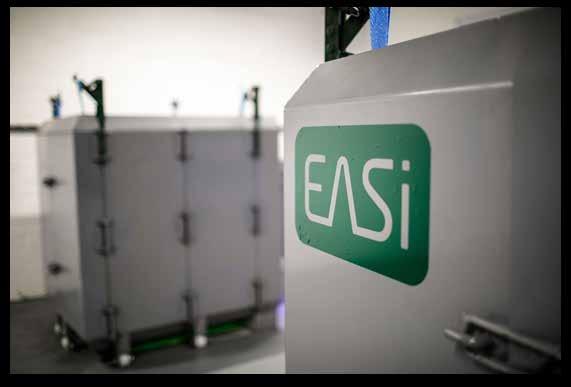




Armatherm™ is one of the leading suppliers of structural thermal break materials for the construction industry. Our goal is to provide architects, engineers and contractors with the knowledge and materials to effectively address thermal bridging issues. Armatherm™ thermal break materials have low thermal conductivity, high strength, and have been designed and tested to carry the loads, whilst reducing the cold bridge within a building envelope.

ARMATHERM™ MASONRY SHELF ANGLE
Material Type: ARMATHERM™ FRR
ARMATHERM™ BALCONY CANOPY
THERMAL BRIDGING SOLUTION
Material Type: ARMATHERM™ Z GIRT

ARMATHERM™ COLUMN BASE
Material Type: ARMATHERM™ 500
ARMATHERM™ PARAPET ROOF PENETRATION
THERMAL BRIDGING SOLUTION
Material Type: ARMATHERM™ 500


ARMATHERM™ FOUNDATION WALL
Material Type: ARMATHERM™ Z GIRT
ARMATHERM™ CLADDING
THERMAL BRIDGING SOLUTION
Material Type: ARMATHERM™ Z GIRT








5 Cairn to construct largest passive house development in Europe
7 New public procurement guidelines mandate 30% minimum clinker substitution in concrete products
7 EPA publishes new National By-Product Criteria for the safe reuse of greenfield soil and stone
9 ESB to transfer Cork site with the potential for 350 homes to LDA
9 Supply Chain Sustainability School Ireland appoints inaugural board of partner representatives
11 John Paul Construction celebrates 75 years of building Ireland
12 Henry McCann announced as Kirby Group Engineering CEO 12 Jim Mintern to succeed Albert Manifold as CRH CEO
13 Designer Group focused on future growth with new appointments to its executive board
13 Cairn announces Bernard Byrne as Chair-Designate
15 Are you ready for the revenue pension tax deadline? – Susan O’Mara, Business Development Manager, CPAS
16 Ireland falling short in sustainable investment to achieve 2030 carbon reduction targets – Marie Donnelly, Chair, Climate Change Advisory Council
20 In Conversation with Sisk – Collaboration is the only way in which we can tackle carbon in a constructive way – Sinead Hickey, Cillian Kelly, Keith O’Flynn, Sarah Melody, Juan A Morillas
27 Taoiseach and Housing Minister officially open Shanganagh Castle Estate
28 Walls Construction – Creating a modern sustainable community
30 Unlocking affordable homes at Shanganagh Castle Estate
34 Springville House right-size sustainable repurposing of existing buildings –MMD Construction and Tuath Housing Association
36 Construction Claims: Key points to consider – Peter McCarthy, Principal, Conlex Consulting
33 The DataCentres Ireland 2024 Conference Programme is Live!!
38 Protecting Your Most Important Assets – Chubb Ireland
40 Ireland’s housing market: Navigating challenges amid demand and development – Construction Information Services
43 Construct Innovate secures €5m in government funding to support six construction research projects
44 Shaping Ireland’s digital construction future: Build Digital Survey and Conference 2024
45 Product Focus: MEDITE SMARTPLY Wood Panel Products
49 Incentivising innovation in the construction industry in Ireland –Guaranteed Irish Construction Forum 2024
50 CIOB and MMC Ireland announce a partnership aimed at securing the sustainability of off-site housing production in Ireland
53 Preparing your organisation for CSRD compliance – Jonathan McKeown, Director of ESG, Davy Horizons
56 Innovation and green finance: The future of sustainable housing – Irene Rondini, Communications Lead and Biodiversity Support Officer, IGBC
58 #ActNowForClimate: Highlights from World Green Building Week 2024
59 All the latest products and services news
60 Are you ready for the Movember Construction Challenge?

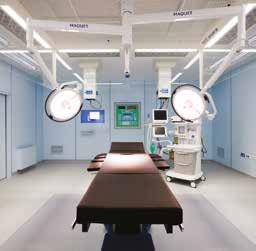
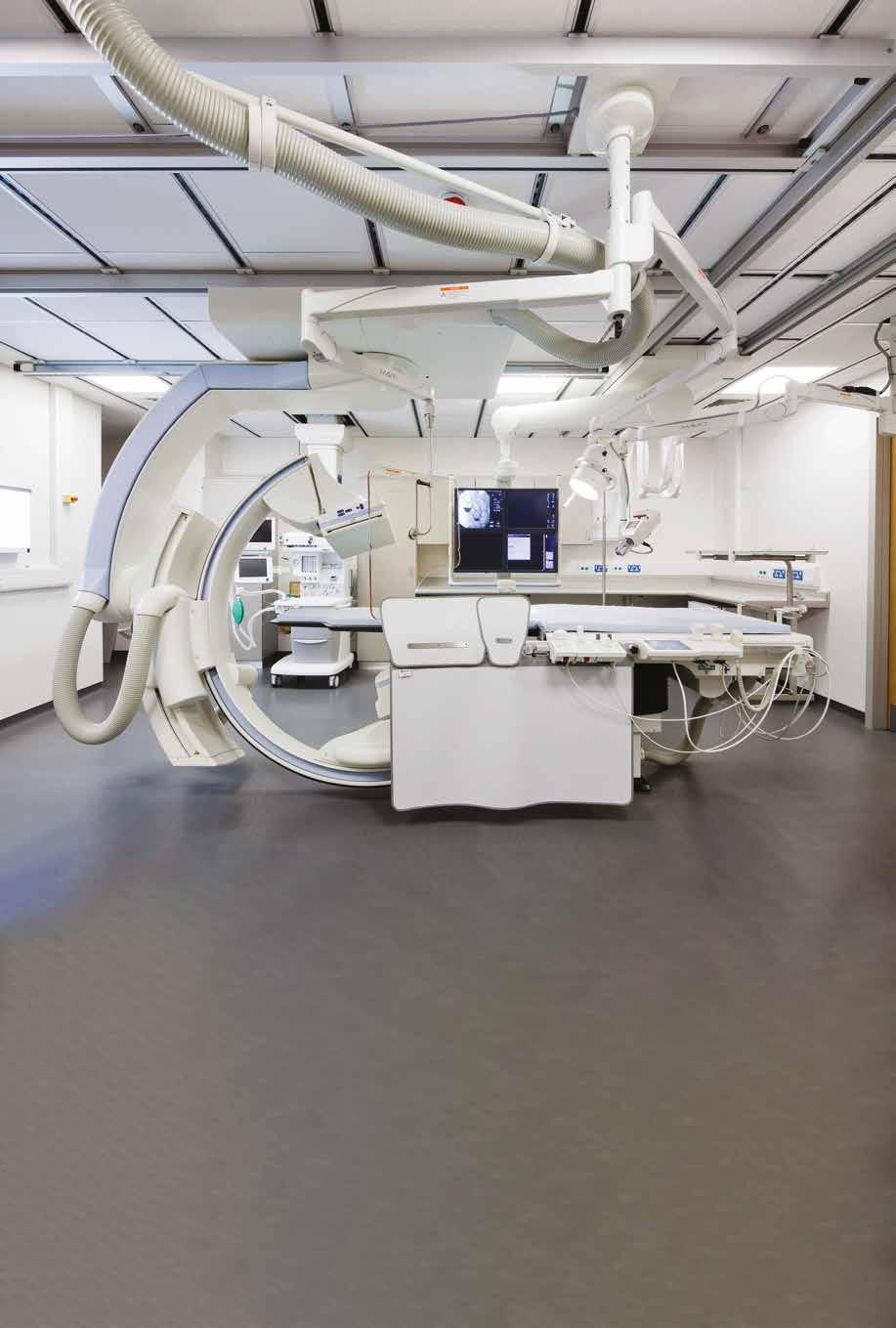
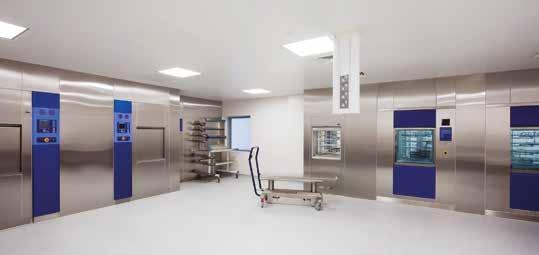

PUBLISHER
Foundation Media Ltd
1 Northumberland Place, Dún Laoghaire, Co Dublin.
Tel: +353 (0)1 677 3157
EDITOR
Robbie Cousins robbie@foundationmedia.ie
DESIGN
Joanne Birmingham
CONTRIBUTORS
Susan O’Mara, Peter McCarthy, Jonathan McKeown, Irene Rondini
PRINTER
WG Baird Ltd
ADVERTISING SALES
Joe Connolly
joe@foundationmedai.ie
Tel: +353 (0)86 396 6158
ADVERTISING AND PROMOTIONAL OPPORTUNITIES
To advertise in Irish Construction News or on www.constructionnews.ie, or to request a ratecard or details of promotional opportunities, contact Joe Connolly at joe@foundationmedia.ie
Cover Image – Shanganagh Castle
Estate – Barry Hennessy, Cathal Healy, An Taoiseach Simon Harris, Housing Minister Darragh O’Brien, Adrian Corcoran and Frank Kelly.
Photographer: Mark Stedman
CONNECT WITH US ON SOCIAL MEDIA
Twitter: @constructionnews.ie
Linkedin: Constructionnews.ie
Facebook: Constructionnews.ie
SIGN UP FOR OUR E-NEWSLETTER
To get the latest news, articles and offers related to the Irish construction industry to your inbox sign up to our free e-newsletter at www.constructionnews.ie
While every effort has been made to ensure that the information contained in this publication is correct, the publisher cannot not accept responsibility for any errors, omissions or discrepancies. Views expressed in this publication are not necessarily those of the publisher.

Over 80% of the buildings we have today will still be standing in 2050. Yet, across Ireland, our cities and towns are dominated by underutilised and energy-inefficient buildings, many less than 50 years old. These structures, while central to daily urban life, present a significant challenge due to their carbon footprints and inefficiencies.
The construction and built environment sector contributes to a substantial portion of global carbon emissions. According to the Intergovernmental Panel on Climate Change (IPCC), the sector is responsible for 37% of all greenhouse gas emissions, with embodied carbon accounting for 14% and operational carbon for 23%. The embodied carbon associated with a new building is, on average, twice that of a deep retrofit. Therefore, retrofitting existing buildings would significantly reduce carbon emissions and contribute to our climate goals.
The Environmental Protection Agency has highlighted the significant impact of the construction industry on waste generation. It estimates that over 50% of all Irish waste is generated by this sector. By prioritising adaptive reuse and minimising unnecessary demolition, we can reduce waste and conserve resources.
To achieve our ambitious climate targets, urgent action is required. The established model of demolishing existing buildings and rebuilding is becoming increasingly unsustainable. New construction often brings its own challenges, such as embodied carbon, material shortages and global supply chain pressures.
If Ireland is committed to halving our greenhouse gas emissions by 2030 and reaching net zero by 2050, we must prioritise the retrofitting of existing buildings. This approach not only reduces carbon emissions but also preserves valuable urban fabric and promotes sustainable development. By investing in energy-efficient upgrades and
adopting innovative retrofitting techniques, we can create healthier, more sustainable and more resilient communities.
In this issue of Irish Construction News, Marie Donnelly, Chair, Climate Change Advisory Council, discusses what she sees as the essential changes needed in construction and the built environment to reduce its carbon footprint. We visit Shanganagh Castle Estate, Ireland’s largest and most energyefficient social housing project, built by Walls Construction for the LDA and DLR.
A group from Sisk’s innovation, procurement and sustainability teams discuss how construction is changing and the new roles emerging in the sector. Jonathan McKeown, Davy Horizons, writes about the key issues many contractors should be considering now in order to meet their CSRD reporting responsibilities from next year.
MEDITE SMARTPLY’s Head of Technical Affairs & Ireland Sales, David Murray, answers questions about new EU regulations for classifying construction materials, and CIOB’s Ireland Policy & Public Affairs Manager, Joseph Kilroy, discusses how the body is contributing to the construction discourse in Ireland.
Elsewhere, we have all the latest construction news and analysis.
Please take a moment to scan the QR code below and sign up for our free e-newsletter. And, if there are any issues or stories you would like to see featured in Irish Construction News, email me at robbie@foundationmedia.ie
Regards
Robbie Cousins
Scan to subscribe to free e-newsletter











































While you ’ ve been building other people’s dreams, your pension has been building too, ready for your dream retirement. But is it time to dream bigger?










You can make Additional Voluntar y Contributions (AVCs) whenever you like for a bigger lump sum on retirement and a better income when you retire CWPS helps you create pensions with strong foundations, so you can keep building your future


AVCs are also a smart and tax e cient way of saving for retirement, as relief from Income Tax is allowed on AVCs at your marginal rate. This means the actual cost to you is less than the contribution amount — thanks to tax relief


Visit w w w.cwps.ie/AVC to find out how you can use this valuable tax relief to your advantage today!










For more information, please contact a memb er of our team: (01) 497 7663 | info@cwps.ie | www.cwps.ie
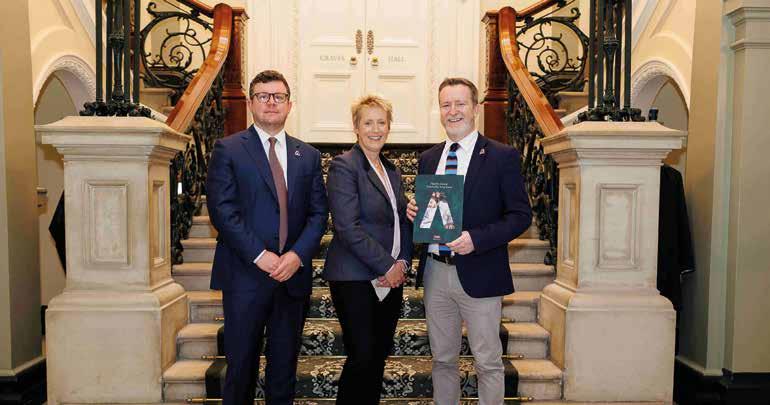
Gavin Whelan, Director of Construction & Operations, Cairn; Emma Osmundsen, Sixty Bricks UK; and Stephen O’Shea, Head of Sustainable Construction, Cairn; at the launch of Cairn’s position paper ‘Passive House - Sustainable Living Spaces’.
Cairn Homes plc is developing Pipers Square in Charlestown, Dublin, with 598 apartments. It will be the largest passive house development in Europe and the history of the state.
Cairn has just launched its position paper – ‘Passive House - Sustainable Living Spaces’ – and is leading Ireland’s construction industry as the first large-scale homebuilder adopting the Passive-House standard, a sustainable building certification that demonstrates how house builders can actively contribute to climate action while addressing the housing shortage and enhancing the quality of life for residents.
Projects such as Cairn’s new Pipers Square development in Charlestown, Dublin, with 598 apartments, are designed to be energy efficient and ideal for high-density living. They offer substantial long-term cost savings for residents due to lower maintenance and operational expenses, with many households potentially never needing to turn on heating, effectively insulating them from extreme energy price shocks and reducing their financial burdens.
Cairn estimates that passive house heating bills are, on average, up to 40% lower than an average new build.
In addition to being energy efficient, passive homes provide greater comfort. While traditionally a home is designed to be heated for eight hours per day, passive houses are designed to maintain a constant temperature of 20 degrees 24 hours a day and provide a constant supply of filtered fresh air.
The announcement represents a key step in delivery against Cairn’s sustainability strategy. The business has outlined targets of reducing Scope 1 and 2 emissions by 46.2% and Scope 3 emissions by 61% by 2030.
In addition to Pipers Square, Cairn is developing apartments to Passive-House Standard in Whitehaven and Niven Oaks in Santry, Dublin 9, and Cooper Square, Seven Mills, Dublin 22. This will result in a further 1,700 Passive-House Standard apartments in 2025.
Commenting on the plans, Cairn’s Director of Construction & Operations, Gavin Whelan, said: “The benefits of the PassiveHouse Standard across Cairn’s four developments include the saving of 75,000 TCO2 (Total Carbon Dioxide), which is the equivalent of flying 68 million air miles.
“We have researched and planned carefully for this to enable
us to be in a position where we can develop these ambitious projects. While passive houses traditionally may have been viewed as a slower, more expensive way to develop homes, we have been working hard to understand how we can build to this standard while bringing Cairn’s typical approach of delivering high-quality homes at scale and pace and that offer value.”
“As we begin to develop passive homes, we will continue to explore new and additional ways to reduce our environmental impact while still improving communities by delivering quality homes.”
Discussing Cairn’s overall sustainability strategy, Head of Sustainable Construction Stephen O’Shea said: “At Cairn, we are actively working to become Ireland’s first large-scale developer to adopt the Passive-House Standard. By adopting the Passive-House Standard for major projects like Pipers Square, we’re showing our commitment to building sustainable, comfortable homes with lower energy bills and reduced emissions. Like the entire construction industry, we know we are on a sustainability journey, but steps like passive house show how we can contribute to climate action and improve the quality of people’s lives.”


As of 01 September 2024, all new public projects in Ireland must adhere to newly introduced public procurement guidelines mandating a minimum of 30% clinker substitution in concrete products used in government and public works projects. This step, announced by the Department of Enterprise, Trade, & Employment in May, marks a crucial milestone in Ireland’s commitment to reducing embodied carbon in construction.
Announcing the mandate in May, the Minister for Enterprise, Trade and Employment, Peter Burke, said that the new public procurement guidelines were an important signal for the sector: “The cement sector accounts for nearly 5% of Ireland’s carbon emissions. As a state, we rely on this sector to provide the raw materials to deliver our ambitious public infrastructure and housing projects. In order to reduce embodied emissions while ensuring construction materials are cost-effective and available, the state has to buy smarter and send a medium-term signal that allows manufacturers to invest in decarbonisation.”

Susan McGarry, Director of Public Affairs and Sustainability, Ecocem Global.
Low-carbon cement manufacturer Ecocem has welcomed the move by the government.
Susan McGarry, Director of Public
Affairs and Sustainability, Ecocem Global, commented: “Mandating green procurement requirements for low carbon cement is a bold step towards developing a more sustainable built environment. The new guidelines are an important milestone on the state’s journey towards reducing embodied carbon and developing a net-zero carbon society and economy by 2050, as outlined in the national policy position.
“The focus on mandating low carbon materials for public procurement and specifically identifying clinker reduction targets will help deliver further decarbonisation in construction.
She added: “More widely, as the largest player in the market, the state is sending a strong signal not only to public bodies but to the wider construction industry that we need to accelerate the pace of decarbonisation and drive innovation in the development of low carbon cements and concretes.
“Ireland is now at the forefront of public policy for cement decarbonisation in Europe. This approach could serve as a model for other countries when looking at ways of accelerating change within an industry, without excessive cost.”
Construction waste is Ireland’s largest waste stream, with over 9 million tonnes generated annually. Over 80% of construction waste is soil and stone. Excavated clean soil and stone are valuable resources that can be reused in other projects. The EPA’s new ‘National By-Product Criteria’ provides rules for safely reusing greenfield soil and stone.
These criteria allow for classifying greenfield soil and stone as a by-product, meaning the material does not become waste. Keeping materials in use is one of the fundamental elements of a circular economy. It enables useful soil and stone materials from one site to be reused for landscaping, reprofiling of land and other similar uses.
Commenting on the criteria, David Flynn, Director, Office of Environmental Sustainability, EPA, said: “Construction is the largest generator of waste in our country, in the region of 9 million tonnes annually, the bulk of this being soil and stone waste. Embracing new approaches to design, materials choice, and modern methods of construction will shift the sector onto a more sustainable path.
“Today, the EPA is streamlining the regulation of construction materials to promote the reuse of useful soil and stone that would traditionally end up as waste. This opens up more opportunities for safe reuse and offers greater regulatory certainty to the industry and stakeholders while ensuring appropriate safeguards remain in place.”
The European Waste Framework Directive prioritises construction and demolition waste. Construction activity comes at an environmental cost, putting pressure on natural resources and biodiversity and generating significant waste. The scale of wasted resources and materials in the construction sector needs urgent
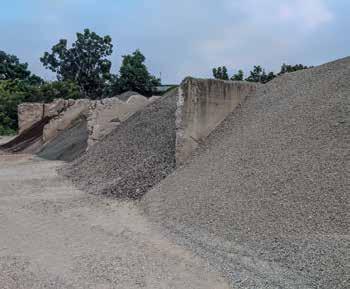
attention.
Warren Phelan, Programme Manager, Circular Economy Programme, EPA, noted: “These criteria present a real and meaningful opportunity for the construction sector to follow a simple set of rules and, in doing so, reduce soil waste from sites and make tangible savings. These latest criteria are the third in a series of national decisions introduced by the EPA to support improved material circularity in the construction sector.”
To download the National By-Product Criteria, visit www.epa.ie

The ESB and the Land Development Agency (LDA) have reached an agreement on the transfer of a site at Wilton in Cork, which has the potential to deliver 350 homes. The land being transferred is located at the energy utility’s Sarsfield Road site in Wilton.
The LDA has appointed a design team for the project and expects to make a planning application for about 350 new homes in Q1 of 2025.
The proposed homes will include a mix of affordable for-sale houses and cost rental apartments. Subject to planning approval, construction could start in early 2026, with the first homes being delivered in late 2028.
The land involved is a 2.7-hectare greenfield site next to the Wilton Shopping Centre and near existing residential neighbourhoods. The location is just over 4km from Cork city centre, with great existing public transport links along Sarsfield Road and new, improved pedestrian and cycle links proposed for the area.
The planned development of the site will add to the LDA’s ongoing activity in Cork. The agency is already in the process of delivering 267 homes at the former St Kevin’s Hospital site in Shanakiel, Cork city, and developing 302 cost-rental apartments at Horgan’s Quay in partnership with BAM and Clarendon Properties.
John Coleman, CEO, LDA, commented: “This is another positive development for the LDA as the agency continues to ramp up the delivery of affordable new homes. We are already under construction

at two locations in Cork, and we look forward to work starting on this well-located site. This planned development will have the potential to provide much-needed housing and new facilities in a desirable area alongside established communities and close to a range of existing amenities and services.
Paddy Hayes, CEO, ESB, said: “We are very pleased that this ESB land at our Sarsfield Road site will make an important contribution to the development of much-needed housing. We would like to thank the LDA for working with us and we look forward to seeing construction underway on what promises to be an excellent development.”
The Supply Chain Sustainability School Ireland has introduced its first board of partner representatives. Comprising distinguished professionals with a wealth of experience across the built environment, this newly appointed board will be crucial in guiding the school’s mission to promote sustainability throughout Ireland.
Joining the board are John Deveraux, Supply Chain Director, John Sisk & Son; David McKenna, Sustainability Manager, John Paul Construction; Fergus McMahon, Director of Commercial and Procurement, Cairn Homes plc; Conor O’Regan, Chief Procurement Officer, ESB; Barry Hennessy, Head of Specification Sales, Saint-Gobain Ireland; Geraldine Fitzpatrick, Head of Roads and Greenways Capital Programme, Transport Infrastructure Ireland; Padraig Twomey, Contracts & Sustainability Manager, Gas Networks Ireland; PJ Ryan, Head of ESG, Construction Industry Federation; and Qian Li, Deputy Chief Procurement Officer, Iarnród Éireann (Irish Rail).
The board will drive the Supply Chain Sustainability School Ireland’s mission to promote sustainable practices within the built environment across Ireland by leading initiatives, providing guidance, and
encouraging collaboration among industry peers.
John Devereaux, Supply Chain Director, John Sisk & Son, commented: “I’m honoured to be joining the board of the Supply Chain Sustainability School. I truly believe that the school will have a massive impact on the built environment in Ireland in terms of education and knowledge sharing across the entire supply chain. The challenge we face as an industry is massive and too big for us to tackle alone; therefore, the school will be key in bringing organisations big and small together to achieve a common goal. I’m excited to contribute to this challenge as best I can and ensure the school in Ireland grows
from strength to strength.”
Launched in Dublin in January 2024, the Supply Chain Sustainability School Ireland is a free virtual learning platform designed to upskill those working within, or aspiring to work within, Ireland’s built environment sector, providing them with the knowledge and tools necessary to build resilient and environmentally responsible supply chains. The formation of a dedicated and experienced board represents a significant milestone in the school’s development.
For more information on the Supply Chain Sustainability School Ireland, visit www.supplychainschool.ie


Make sure you are protected
Contact Peter McCarthy LL.M.,BSc., FSCSI, FCIArb
Cork: +353 21 455 5678
Dublin: +353 1 639 2927
Email: peter@conlex.consulting
We specialise in contract support for the Construction Industry, providing solutions to commercial risk throughout the life cycle of a construction project including:
→ Pre Contract Review
→ Post-Contract Support
→ Preparation, Defence and Negotiation of Claims
→ Payment Dispute Resolution
→ Construction Contract Training
Our goal is to protect the financial interests of main contractors and sub-contractors of all sizes giving you peace of mind!

On Tuesday, 17 September, John Paul Construction marked a significant milestone: its 75th anniversary. A grand celebration was held at the iconic Shelbourne Hotel in Dublin, bringing together clients, past and present colleagues, members of the founding families, and industry stakeholders.
The evening served as a platform to reflect on the company’s rich history and remarkable achievements. Established in 1949 by John Paul and Tom Simington, John Paul Construction has played and continues to play a pivotal role in the development of Ireland, contributing to numerous landmark projects over the years.
To mark the occasion, the company launched a commemorative book titled ‘Built for Change’. This publication delves into the company’s journey, highlighting its growth and evolution alongside the transformation of Ireland itself. The book offers insights into the challenges and triumphs faced by John Paul Construction throughout its 75-year history.
As the celebration unfolded, attendees had the opportunity to connect, network, and celebrate the company’s enduring legacy. The event served as a testament to John Paul Construction’s commitment to excellence and innovation, as well as its enduring impact on the Irish building industry.


Kirby Group Engineering has announced that CEO Mark Flanagan will step down on 01 January 2025 after five successful years in the role. As part of a planned and structured transition process, Henry McCann will step into the role of CEO, having spent the past five years as group operations director at the Limerick-headquartered company.
Mark Flanagan has successfully led the 60-year-old Kirby Group Engineering through an unprecedented period of profitable growth and international expansion, establishing it as a key leader in the international M&E engineering and construction industry.
Kirby now employs over 1,800 people and is on track to record turnover above €700m in 2024. Flanagan will continue supporting the company as executive director, supporting Kirby’s sustained growth.
As he approaches the latest milestone in his career, Mark Flanagan said: “Change is a constant, and it creates exciting opportunities, which have put Kirby Group Engineering in a strong position. We believe it is well placed for the future thanks to our consistent approach to client service through the ‘Kirby Way’ and in structured and proactive planning. Nowhere is this approach more evident than in how we focus on having the right leadership and people in place through our succession planning, which aims to ensure we can lead in meeting the needs of our valued customers into the future.”
Henry McCann has played a pivotal role in Kirby’s expansion and developing of its organisational capabilities, notably leading the Kirby Way initiative. He is determined that helping people reach their full potential will be a key priority for his term as CEO.

McCann comments: “I am passionate about focusing on people and the further development of Kirby as a learning and teaching organisation. I have also developed a strong instinct for understanding and pre-empting our valued clients’ needs which is key to building sustainable partnerships that can deliver real value into the future.”
Kirby’s past eight years have been a stellar record of achievement and sustainable delivery and growth under the leadership of Jimmy Kirby and Mark Flanagan. Jimmy Kirby continues in his role as executive chair and is leading the development of our South African office.
CRH plc has announced the appointment of Jim Mintern as its chief executive officer (CEO), succeeding Albert Manifold, who retires at the end of 2024.
Jim Mintern is CRH’s Chief Financial Officer and has been a director of its board since June 2021. He has over 30 years of experience in the building materials industry and 22 years with CRH, serving in various senior leadership roles.
Albert Manifold has held varied responsibilities with CRH since he joined in 1998. He was appointed CEO in January 2014. He will step down from the board and relinquish his executive duties on 31 December, 2024, continuing as an advisor to CRH for a further 12 months.
Announcing the appointment, Richie Boucher, Chairman, CRH, said: “The board has a significant focus on succession planning throughout CRH. With the support of independent advisors, we have followed best practice, including a review of external candidates, and we have carefully monitored the development plans for potential internal candidates.
“Over recent years, we have closely observed Jim’s character, qualities and abilities, as well as his significant influence on the evolution of CRH. We are very pleased to have a successor of such calibre and are confident that Jim is best positioned to lead the CRH team, building the future of
the company for the benefit of our investors, customers, colleagues and communities.”
Albert Manifold commented: “I am pleased that Jim, who has a deep understanding of CRH, will succeed me when I retire at the end of this year. This will be his time. Jim’s experience, capabilities and ambition for the business ideally position him to lead the CRH team forward through an era of enormous opportunity.
Jim Mintern commented: “It is an
incredible honour for me to be appointed the next CEO at such an exciting time for CRH.
“CRH has an impressive legacy of continuous growth and financial performance by providing value-enhancing solutions for its customers. I look forward to working alongside our highly talented team as we build on this foundation and continue to successfully grow the business while delivering exceptional returns for our shareholders.”
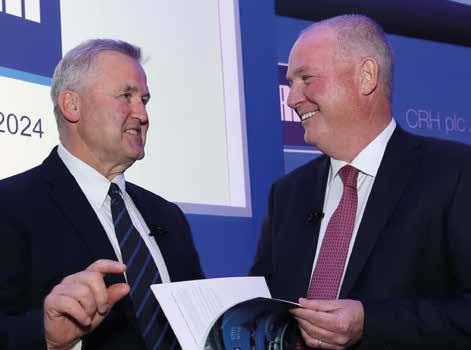
Designer Group has announced the appointment of new executive directors to the company’s board.
The following appointments have been made: Paul O’Donnell, Executive Director and Chief Financial Officer; Sean Greally, Executive Director and Chief Commercial Officer; Gary Byrne, Executive Director with responsibility for Energy, Industrial & Life Sciences; Catriona Gallagher, Executive Director with responsibility for Data Centres; Adrian O’Leary, Executive Director with responsibility for Building Services.
Making the announcement, Paul Nicholls, Group Managing Director, Designer Group, said that the appointments reflect the company’s ambitious growth plans as it builds on a 32-year heritage of success in Ireland and abroad.
Paul Nicholls commented: “I am delighted to announce the expansion of our executive board with experienced industry leaders who share our values and vision to grow our operations for the benefit of our clients and staff. We are committed to not only expanding our footprint but also doing so responsibly, ensuring a legacy of innovation and excellence in our work.
“We have also reorganised our business to focus on three key sectors: Energy, Industrial & Life Sciences, and Data Centres and our traditional core sector of Building Services. As a company and as a leadership team, we are deeply committed to enhancing our
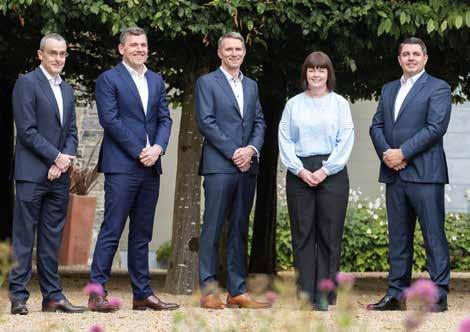
Director and Chief Commercial Officer; Paul O’Donnell, Executive Director and Chief Financial Officer; Paul Nicholls, Group Managing Director; Catriona Gallagher, Executive Director with responsibility for Data Centres; Gary Byrne, Executive Director with responsibility for Energy, Industrial & Life Sciences; and Adrian O’Leary, Executive Director with responsibility for Building Services.
delivery standards, ensuring that our clients receive nothing short of the highest quality and service.”
Paul Nicholls said the company has continued to expand its footprint with many significant client projects completed. “We have secured our reputation in the data centre sector with the completion of five data centres projects on three different campuses in two different countries in the Nordics region.”
He noted that Designer Group, committed
to achieving net zero by 2035, is leading the industry in helping clients meet sustainability goals, recently completing a major decarbonisation project for an international drinks company in Africa and Mexico. “Together with our clients, we are not just building projects; we are building a more sustainable future for us all”, he said. “With over 1,250 employees, our focus remains on inclusion, innovation and investment as we continue to grow our business.”

Cairn Homes plc has announced the appointment of Bernard Byrne as an independent non-executive director and Chair-Designate, effective 01 January 2025. Bernard Byrne will succeed current Chair, John Reynolds, who will retire at the end of April 2025, having served as non-executive Chair since Cairn’s IPO in 2015.
Bernard Byrne is a chartered accountant who brings a wealth of leadership, finance and commercial experience to Cairn and a deep understanding of the Irish market and economy.
Michael Stanley, CEO, Cairn, commented:
“Cairn will celebrate its tenth anniversary in 2025. John Reynolds has served as Chair since Cairn was founded and has been an integral part of the company’s growth and success over the last decade. I am delighted to welcome Bernard as Chair-Designate to succeed John at the end of April 2025. Bernard brings an impressive track record of leading very large private and public Irish companies. John Reynold’s contribution as chairman since our IPO has been invaluable to Cairn, and I look forward to working with both him and Bernard during the upcoming handover period.”

As a wise man once said, the best way to eat an elephant is to do it one bite at a time. That’s true of your finances as well.
If you’re looking to prepare wisely for your retirement, manage your savings and investments, and protect your financial wellbeing, the best time to start is now. Call us today, and we’ll get your money working for you. Every year counts, so don’t leave your plan to the last minute.
Future you will thank you



SUSAN O’MARA, Business Development Manager, CIF Pension
(CPAS), suggests some points you might consider with this year’s revenue pension tax deadline, 31 October, approaching.

Unlike summer, soccer, or award season, pension season is not high on the list of exciting times for most people. Understandably so!
Pension season is the period leading up to the revenue pension tax deadline on 31 October. It is a time for both self-employed individuals and employees to consider making a lump-sum pension contribution.
If you are self-employed, you will be finalising your tax return at this time of the year. By making a lump sum pension contribution, you can choose to backdate the tax relief to 2023 as part of your tax return to Revenue and use the backdated tax relief to reduce any tax due for 2023. This must be completed by 31 October, or if you pay and file your taxes online, you can avail of the extended ROS deadline to file which is 14 November 2024.
If you are an employee, you can also take advantage of this deadline. You can make a lump sum pension contribution known as an additional voluntary contribution (AVC) and claim the tax back from the previous year. For example, an employee who makes an AVC of €10,000 in 2024 can claim back €4,000 (if paying tax at 40%) from 2023.
For both self-employed contributions and employee AVCs, here are the limits on the amount you can contribute based on your age:
• Under age 30: 15% of Remuneration
• Age 30 to 39: 20% of Remuneration
• Age 40 to 49: 25% of Remuneration
• Age 50 to 54: 30% of Remuneration

• Age 55 to 59: 35% of Remuneration
• Age 60 and over: 40% of Remuneration
Please note the AVC limit is the combined value of the AVC and any normal pension contribution.
“Remuneration” is defined as all income assessable under schedule E from this employment, including benefits in kind and the value of shares provided under a Revenue-approved share purchase plan. This is currently subject to a maximum of €150,000.
You will move from one contribution band to the next on 01 January of the tax year that includes your relevant birthday.
The lifetime pension limit, also known as the Standard Fund Threshold, is the
maximum total benefit an individual may receive from all tax-approved pension arrangements, including the pension plans of previous employers. Currently, the lifetime limit is €2 million. Recently, Minister for Finance Jack Chambers outlined a decision taken by the government to phase an increase in the SFT of €200,000 per year beginning in 2026 until 2029 to a total of €2.8 million.
AVC’s - Are there other advantages?
Aside from the value of the tax relief, the value of the fund you build up making AVCs and any other pension contributions is to fund a better lifestyle in retirement. The state pension is currently just under €14,500 per annum. All income funded through your pension and AVCs are going to enhance your financial wellbeing when you are ready to stop working.
Finally, if you are an employee and do not have a lump sum to spare to invest in an AVC, you can still take advantage of the generous tax relief. AVCs can be made through your weekly or monthly payroll, and even better – the tax relief will be granted at source. In other words, it is done for you. Talk to CPAS, or your pension provider, to discuss what works for you, visit https://cpas.ie/avc for more.
About CPAS
CPAS are the specialists when it comes to pension provision and financial advice for employers and staff in the construction sector. CPAS administer the Construction Workers’ Pension Scheme and the Construction Executive Retirement Savings (CERS).
For more details, contact Susan O’Mara via email susan@cpas.ie or phone 01 223 4949
Climate Change Advisory Council Chair Marie Donnelly tells ROBBIE COUSINS that Irish construction faces critical sustainability challenges but is moving in the right direction. However, the government must urgently tackle decarbonisation of our fossil fuel culture to avoid over €8bn in EU fines in 2030.
The Climate Change Advisory Council is the independent body tasked with assessing and advising the government on how Ireland can achieve the transition to a climateresilient, biodiversity-rich, environmentally sustainable and climate-neutral economy. Its chairperson, Marie Donnelly, is a former director of the European Commission with Responsibility for Energy Efficiency, Renewable Energy and Innovation.
As part of her remit, within construction, Marie Donnelly has been calling for increased timber usage and greater utilisation of modern methods of construction (MMC). She says the government should be doing more to encourage and facilitate the retrofitting of existing homes and that it must make decarbonising the systems that heat our homes an even higher priority.
Marie Donnelly also warns that if Ireland does not achieve its carbon emissions reduction targets by 2030, we could face an EU fine of €8bn, adding that it makes sense to spend this money now on mitigation initiatives.
She explains: “Ireland could face EU fines of €8.2bn after 2030 if we miss our climate targets.”
In 2023, the Department of Public Expenditure estimated compliance costs between €3bn and €8.2bn, based on the EPA projections and future ETS prices.
“We urgently need to phase out fossil fuels and expand retrofitting incentives. We should increase grants for heat pumps to make them a more affordable alternative to fossil fuel boilers. Fossil fuels must be phased out so people can make sustainable choices to heat and power their homes.”
Within the context of embodied carbon, Donnelly says the materials we use to build very much dictate the level of carbon emitted by the process.
“In the building process, cement is one of our key targets for reducing emissions. It’s a very high emitter of greenhouse gas (GHG). Global emissions from cement manufacture stood at 1.6 billion metric tons of carbon dioxide in 2022.
“You can reduce the emissions from cement production to some extent, and

this is being done. The government’s new Clinker Mandate is one way of doing this. Alternative fuels could also be imported into the process. But the problem is that, at the moment, the product and the process produce very high emissions. This is why we are pushing for the use of alternative, more sustainable methods of construction.”
She continues: “Timber is a renewable resource. You have embodied carbon in timber used in construction, and growing forests locally means we will take even more emissions out of the atmosphere. From a climate perspective, timber has a huge role to play in terms of reducing emissions in the construction of buildings.”
Marie Donnelly points out that greater energy efficiency is the key to reducing operational carbon emissions.
“Many energy efficiency goals are being addressed through our building regulations. Our legislation for new buildings is good. However, we have a considerable challenge in reducing emissions when it comes to existing building stock, particularly housing.
“We have about 2.2 million houses in the country. The heating systems in most are fossil fuel based, either gas or oil. In order to reach our emissions-reduction targets, on top of insulating homes, we need to decarbonise domestic heating systems.”
She says once again, we have the technology to do this, and this presents an opportunity for Ireland to lead the EU by making the technology more affordable. Otherwise, people will continue to install fossil fuel systems.
“The technology of heat pumps is established. However, there is a capital

investment gap that needs to be bridged. We have been urging the government to reduce the capital costs of these technologies. For illustration purposes, say a heat pump costs €14,000 to install and the home-owner gets a grant of €6,500, the gap is still €7,500. Suppose the gap was €4,000, with the grant being increased to €10,000. Then, you’re almost competitive with fossil fuel boilers in terms of capital costs, but the running cost of the heat pump system would be much lower than the boiler.
“Many people don’t have the capital for the upfront investment. We argue that the government providing capital investment now secures the change cost-effectively without causing huge cost increases in the economy. By front-loading the expenditure, the government is also reducing our emissions and mitigating those possible fines coming down the line in 2030.”
Looking at transport and infrastructure, Marie Donnelly asks if we want to build out roads or build spaces for people.
“Our philosophy on transport is on road space reallocation. Space should be reallocated for people rather than being there for cars to be parked 12 hours a day. Paths should have sufficient space for people to walk, push prams or wheelchairs, etc. We also need safe spaces for active travel, such as cycling and more space for public transport, avoiding congestion and allowing public transport to deliver the service it is supposed to provide.
“The CCAC is not calling for the elimination of cars. The issue with cars is why are we using cars for short distances of 2kms or less. We should be able to walk, cycle or take public transport for this distance. We support compact development
concepts such as the 15-minute city.”
Marie Donnelly believes that when it comes to planning, Ireland needs to carry out a full assessment of the available land and zone it appropriately for the purpose for which it is best suited. Development plans that are put in place should not change. Those investing in crucial infrastructure projects should be confident that their proposals align with development plans without worrying about the development plan changing.
“Planning is an extremely sensitive point, but it shouldn’t be so. We’ve looked at procedures and mechanisms in other countries where planning and development plans are clearer. They’re more prescriptive, but they’re sufficiently clear that if a developer looks at the plan, they know the answer to what will be acceptable in a particular area and don’t have to take a flyer on getting through the planning system. Clarity in planning would be very helpful, with areas zoned for specific uses or not zoned.
“In France, where planning is spatially based and map-illustrative, look at a map and the map will tell you what the zoning is for a locality, and that’s it. In Ireland, our development plans are frequently indicative and can be varied. Long-range development plans are a good idea. In one recent instance, An Bord Pleanala refused planning for four wind farms. The proposers of the wind farms started their work when the local development plan allowed for windfarms. Halfway through the planning process, the development plan was changed to prohibit wind farms. So, Bord Pleanala could only say no. This is a disincentive to managed development and roll out.”
The CCAC is firmly in favour of repurposing existing and derelict buildings and wants more brownfield sites in urban areas opened up and made more attractive to develop.
Marie Donnelly explains: “We should not be throwing away embodied carbon in buildings. We’ve seen research that suggests, to date, we have not made a dent in vacant properties. We continue to press the government on this, and rather than have new development move outside towns to greenfield spaces, we must make brownfield sites more attractive in terms of construction and development.”
According to the 2022 Census, there were 153,192 residences categorised as local authority homes. Marie Donnelly says that the people who live in these properties are the audience that is most at risk in terms of the cost of heating and inflationary impacts.
“It is evident to us that the government should prioritise these properties for retrofitting. It’s their own property. However, it is not addressing the issue of retrofitting these homes fast enough, and the level of retrofit being carried out does not go far enough.
“We believe the National Retrofit Plan should be more comprehensive in scope and ambition. It shouldn’t just be about roof and wall insulation and upgrading. We should also be installing solar panels and heat pumps and looking at how each home will function into the future.
“Solar panels should be everywhere because they provide an opportunity for people to reduce their electricity costs while at the same time going back to my point about decarbonising and reducing fossil

fuel reliance.”
Marie Donnelly adds that people on the verge of retirement or recently retired should be a targeted cohort to ensure their homes are adequately retrofitted.
“People in their 60s at pre-retirement and just post-retirement stage in most instances might own their house and may be in it for 30 years or more at this stage. They probably haven’t done a lot in terms of improving the fabric of the building over that period. The question is, what would make them want to retrofit now to have a warm house for their retirement.”
“Many people in this situation may be worried about the costs and wonder if they would get a return from the investment. There are also questions about the impact of retrofitting. Do they have to move out for long? If so, where are they going to move?
This cohort has greater difficulty making and implementing the decision to retrofit. The government should specifically support this group, perhaps through information clinics. They are prime property owners and should be encouraged to retrofit.”
Contributing to the ambitious targets of the European Strategic Energy Technology Plan, the programme’ Positive Energy Districts (PEDs) and Neighbourhoods for Sustainable Urban Development’ supports the planning, deployment and replication of 100 Positive Energy Neighbourhoods by 2025.
While the CCAC absolutely favours retrofitting, it is also concerned about decarbonising fossil fuel-dependent heating networks.
“Heating decarbonisation is a more urgent action. Retrofitting will take time. But the decarbonisation of the heating
system can be done through district heating and that’s why we’re pushing the district heating option.”
Fourth Generation District Heating Networks are designed to work at lower temperatures and enable a more costeffective transition away from burning fossil fuels toward heat supplied from local renewable and secondary heat sources, such as from waste heat or heat transfer from groundwater. The PED initiative mentioned above could play an essential role in decarbonising Ireland’s heating network.
“An SEAI Heat Study says that over 50% of heating requirements can be met with surplus heat from district heating systems in Ireland. The new generation of district heating systems are very efficient. Look at our new urban spaces and the layout of residential communities, often there’ll be a substantial green space perimetered by houses. This configuration lends itself to district heating. You only have to dig up the road to put pipes down to feed all the houses.
“The attraction of this is the heating is decarbonised, even though the houses may not yet be retrofitted. Whether retrofitted or not, they will not be wasting energy because they will be connected to a renewable district heating system, which, incidentally, should work with their existing radiator configuration.
“Granted, there’s an infrastructure investment that needs to be made. But this approach will bring us closer to achieving our decarbonisation objectives faster than we are currently going.”
Marie Donnelly suggests a more suitable home configuration for fourth-generation district heating systems and communal retrofit programmes.
“The residential terraces of our town and city centres are ideal for the government
to deliver retrofit programmes at scale and supply heating from district heating schemes.
“It has been demonstrated in other countries. I often cite the example of the Energiesprong (Energy Leap) programme, which originated in the Netherlands and has since been implemented in parts of the United Kingdom, the United States, France, and Canada. This programme involves snapping a shell of panels to the outside of a building to increase its thermal efficiency. The cladding is made to measure off-site, embedded with insulation and service ducts, and solar panels installed on roofs. The installation can be completed in a day, and the terraces are ideally located to be switched over to district heating systems.”
Marie Donnelly concludes by saying that in construction, the most effective tools we have are legislation, standards and building regulations. These are updated regularly and are ambitious and forward-looking. She adds we also have a construction sector that is innovative and ambitious.
“As we move to the ZEB building standard in the coming years, solar panels will be the norm on all buildings. It won’t be the exception anymore. So why are we waiting until 2028 to do this? Why don’t we do this now? Why postpone until tomorrow, something we know we should do today? It will also be a lot cheaper to install today.
“The CCAC is here to advise and make recommendations on best practice. The recommendations we make are practical interventions that make economic as well as environmental sense. The government needs to be moving quicker, not just in construction, but in other sectors too, if it is serious about achieving its 2030 carbon emission reduction targets,” Marie Donnelly concludes.


In Conversation with Sisk – Collaboration is the only way in which we can tackle carbon in a constructive way
Irish Construction News recently met with some members of Sisk’s innovation, procurement and sustainability teams to discuss how the construction sector is changing and what this may mean for Ireland’s next generation of construction professionals.
The construction industry has undergone a significant transformation, shifting from traditional, labour-intensive practices to more modern, digital, and sustainable approaches. Historically reliant on manual methods and onsite labour, the sector is embracing technologies like Building Information Modelling (BIM), artificial intelligence, and automation. These tools streamline design, project management, and construction processes, reducing costs, enhancing accuracy, improving safety, and reducing carbon emissions.
Off-site construction methods, such as prefabrication and modular building, enable faster project completion and higherquality builds, as components are manufactured in controlled environments before being transported and assembled on-site. This shift promotes sustainability by minimising waste, optimising material usage, and reducing the carbon footprint of construction activities.
As the industry evolves, new job roles are emerging to support these advancements. Digital construction specialists, geospatial engineers, data analysts, carbon managers and sustainability reporting managers are increasingly in demand, replacing or complementing traditional roles. Additionally, green building initiatives create opportunities for experts in renewable energy systems and environmental engineering, aligning the sector with global sustainability goals.
This ongoing transition is reshaping how buildings are designed and constructed and revolutionising the workforce, requiring a blend of technical, digital, and environmental expertise. The future of construction is digital, off-site, and green, creating a more efficient, eco-friendly industry.
Sisk began its digital transition journey over a decade ago, adding sustainability to the mix in more recent years. These changes have
created many new roles and a restructuring to promote greater collaboration between team members, consultants, supply chain and clients.
Irish Construction News recently gathered some of Sisk’s new generation of professionals to discuss how they see their roles in the contractor’s transition and what they believe the construction industry of tomorrow should look like.
Cillian Kelly is Sisk’s Head of Digital Project Delivery (DPD). He directs digital engineering information management and digital technology, which include smart building technology, geospatial services and drone operations across Ireland and Europe. He is involved in projects from pre-construction through delivery and on to operations. His function results in improved decision-making, increased certainty of delivery for clients and cost savings for the company.
Juan A Morillas is Sisk’s Head of Sustainable Design. His role focuses on sustainable design and carbon management and reduction. His team helps clients and those working on Sisk projects reduce the embodied and operational carbon of those projects from a design perspective. This is achieved by reviewing designs received from clients and optimising these to present greater carbon reduction opportunities.
Sarah Melody is Sisk’s MMC Integration Lead. Operating out of Sisk’s Design and Innovation Department, she facilitates MMC team collaboration across the different functions and business units, ensuring that the innovation work Sisk does with academia reaches sites and innovation on sites is recorded and fed back across the business.
Sinéad Hickey is Sisk’s Head of Sustainability for Ireland &

Europe. She is responsible for a wide range of sustainability initiatives, such as the operationalisation of Sisk’s 2030 Sustainability Roadmap, sustainability reporting, social value and social impact and supporting Sisk’s sustainability and energy management systems to ensure they are ISO14001 and ISO50001 compliant. Managing strategic stakeholder engagement across the organisation and the wider value chain is another important element of her role.
Keith O’Flynn is Sisk’s Group Supply Chain Sustainability Manager. His function sits between Sisk’s sustainability department and supply chain department. He is the link for the supply chain in terms of sustainability, including environmental, biodiversity, social and any other ESG factors. A key current responsibility is to lead Sisk’s engagement with the supply chain to reduce the contractor’s Scope 3 emissions, which account for over 98% of total emissions.
Sisk’s move to its new head office in Citywest in May 2024 saw it working with MOLA Architects and its supply chain partners to implement its teams’ expertise in digital and sustainable construction practices. The retrofitted premises have been awarded LEED Gold status and employs the latest building management technologies, such as a detailed as-built BIM model with IoT sensors providing real-time data, creating a smart building digital twin to ensure all functions are optimised. Its open, free-flowing layout is designed to facilitate a greater sense of collegiality and interdepartmental collaboration, keeping occupant comfort at its core.
Cillian Kelly (CK) was part of the team that oversaw the headquarters’ refurbishment.
CK: “Sisk acquired this building in October 2023. We started construction just after Christmas, and we were moving in by Easter. Our DPD, design and carbon teams collaborated on a sustainable design to reduce embodied and operational carbon. With limited building documentation, our geospatial team conducted a point cloud laser scan survey, and we developed a BIM model as the design foundation. Mola Architects designed open interiors in a form of gallery, in other words, breaking down the open plan into more manageable spaces, and they engaged with various company departments to ensure the building met all our requirements.

“After 60 years of Sisk operating at Wilton Works, this marks a significant shift in our work environment, embraced by all for the communal approach we took. The DPD team implemented technology for seamless in-office or remote working. With over 300 headcount and desk sensors, the building allows us to monitor occupancy and utilisation. Our workplace app helps staff coordinate meetings or support flexible working.
“We’ve integrated our digital twin with the building management system, combining occupancy and energy data to optimise performance. This technology allows us to showcase our DPD approach to clients and helps them understand the added value we can bring to their projects. We would encourage all existing and potential clients to get in touch, as we would be more than happy to give them a tour and demonstrate our smart building, which might help them when deciding what to include in their next project or upgrade of existing building stock.”
Sarah Melody (SM): “The retrofit aspect of the new head office is a critical feature. A 2020 European Commission report noted that 85-95% of buildings from 2020 will still exist in 2050, yet only 1% are renovated each year. Reusing buildings is a key reason we chose this one. Older buildings can be functional, and the reconfigured interior of our new offices facilitates collaboration and transparency. The central Wilton Café has been transformational, allowing spontaneous interactions that weren’t possible in the previous offices. Additionally, our individual building app enables us to easily locate colleagues on campus, facilitating greater collaboration opportunities.”
CK: “We can replicate this in other buildings for clients, such as healthcare, commercial, data centres, life sciences and manufacturing facilities. We scan the premises, create a BIM model, and our design and sustainability teams will collaborate to develop low embodied and operational carbon smart building solutions.”
Cillian Kelly’s journey to becoming Sisk’s Head of Digital Project Delivery mirrors the construction sector’s digital adoption journey. Outside of Sisk, he serves as the CIF’s Digital Construction Ambassador and has helped facilitate sector-wide digital progress
If you’re a property developer or builder embarking on a new development, the relevant authorities,, often the municipality or local authority, may require you to provide bonds that serve as a guarantee that you’ll complete the necessary infrastructure, especially concerning roads and sewers.
Infrastructure Bonds: These bonds ensure that the roads and sewers associated with your development meet the required standards. They also specify a defined timeframe for completion.
Condition for Development Permission: When you receive permission for development, the planning authority may attach a condition. This condition requires either a cash lodgement or a surety bond to be set aside. If additional work becomes necessary due to a developer or contractor failing to meet the required standard, the bond will cover those costs. This condition is known as the “Taken in Charge Standard.”
Policy and Completion: Development Bonds ensure that the planning conditions

specific to your project are met. The council or local authority typically maintains these bonds until the development is completed to the satisfaction of the planning authority, as per the planning conditions.
BBi Ireland – The Ideal Partner for Bonds.
Quality Options: We partner with experienced, approved insurers specialising in development and surety bonds. Efficient Service: Expect a swift response once all necessary information is provided. Proven Expertise: Our understanding of
various contract types and requirements means we’re well-prepared to handle anything from local government contracts to standard building projects.
Why Trust BBi with Your Bond Needs?
Market Insight: We leverage our market understanding and your specific business needs to find the optimal bond solution. Internal Financial Expertise: Our team is equipped with the specialised financial knowledge required to assess your requirements.
Client-Focused Support: With various options at hand, we guide you in selecting the bond provider that best fits your needs.
Safeguard your developments or contracts and ensure your projects proceed without a hitch.
Call us on +353 49 433 1038 to get started today or visit bbiireland.ie to find out more. Berns Brett Ireland Ltd t/a BBi Ireland is regulated by the Central Bank of Ireland. Registered office: 7 Townhall Place, Townhall Street, Cavan. Registered in Ireland No. 543820.
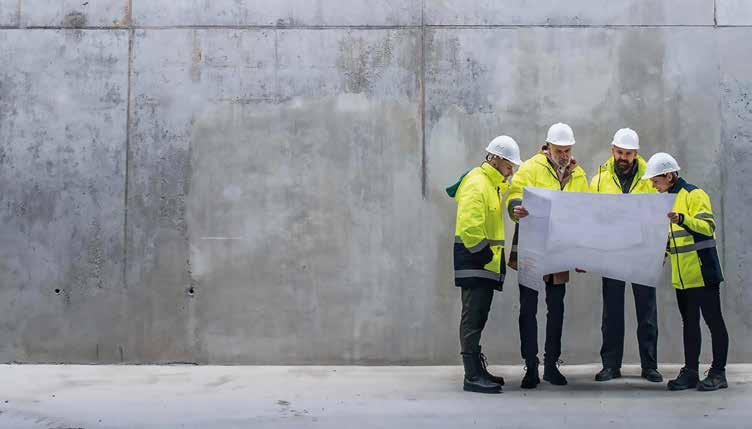

through the CIF Construction4.0 Committee.
CK: “I joined Sisk in 2011 as a site engineer/labourer and, with my architecture/construction management background, quickly became one of the first BIM pioneers in Sisk. By 2013, we began building our DPD department, driven by client requests for better information management and 3D coordination to aid MMC fabrication and reduce rework, waste and embodied carbon. As we grew our DPD team, we helped consultants and subcontractors upskill to work in tandem with us.
“In 2016, Sisk was PAS1192, later ISO19650, certified, and we worked with CIF to form the Construction 4.0 Committee. Today, Sisk has senior information and BIM managers leading specialist digital teams across various sectors to provide accurate information and project certainty. We have a 4D planning team that works with the overall planning team and construction operations, conducting digital rehearsals and developing planned sequences for how projects will be delivered. Our geospatial team can scan new and existing projects to create accurate survey data, and our drone operations provide aerial footage for progress updates and aerial surveying for 3D calculation to support our engineering and commercial teams.
“Our DPD team introduces smart technologies to improve efficiency and reduce workloads. Over the past decade, we’ve grown significantly, attracting top talent and industry recognition globally. We have an early graduate programme with third-level institutions. It’s an exciting time to be in construction, and we in Sisk are proud to lead our industry’s digital transformation.”
Part of Juan A Morillas’ (JM) role is to incorporate carbon reduction into Sisk’s project designs.
JM: “We get requests from clients to carry out life cycle assessments of projects. We conduct two types of life cycle assessments: ‘As-Designed’ and ‘As-Built.’ For ‘As-Designed,’ we assess a design’s carbon impact before construction. For ‘As-Built,’ we evaluate the final building to measure the effects of design or material changes during construction.
“Collaboration between our digital, sustainability and procurement teams is crucial to the success of these assessments. Without detailed BIM models, we extract data from Bills of Quantity. Collaboration enables us to make informed decisions that

help reduce carbon footprints.”
JM: “Early involvement ensures better carbon results since we can plan effectively and monitor materials and site movements. Our supply chain knowledge enables us to provide accurate carbon data to client design teams. We can, in many instances, recommend lower-carbon alternatives for materials, drawing from our extensive product database and supplier insights.”
On the day of our meeting, Sinéad Hickey (SH) and Keith O’Flynn (KO’F) hosted an industry meeting of the Supply Chain Sustainability School Ireland committee elsewhere on campus and took time out to join the conversation to explain how sustainability touches every element of Sisk’s operations today.
Sisk’s Head of Sustainability, Sinéad Hickey, highlights that new EU directives like the Corporate Sustainability Reporting Directive (CSRD) offer contractors and suppliers the chance to structure and report data in a consistent and comparable way. And, while the directive doesn’t necessarily demand action, companies who act on their data to drive improvement should gain a market edge and, more importantly, will help to reduce construction’s carbon footprint.
SH: “At Sisk, we integrate sustainable practices through a process-driven approach, guided by standards such as ISO 14001, ISO 50001, ISO 20400 for Sustainable Procurement and BS8001 for Circular Economy Principles. We will now look to the Double Materiality Assessment (DMA) process as directed under the CSRD to identify and manage the key material issues across our business.
“Health & Safety, for example, is crucial and aligns with ESRS S1 Own Workforce Standard.
“The DMA will help us focus on the most important issues in our business, and then we can determine how to address them.
“Our 2030 sustainability roadmap has aligned us on key issues, with our sustainability report reflecting progress made. While compliance with CSRD is essential, our goal is to use data to drive real improvements, reduce emissions, enhance diversity and help our supply chain follow suit.
“Overall sustainability is brought together and guided by the standards that we have in place. When sustainability, design and supply chain come together, sustainability gets embedded across the organisation. And this can’t happen within one function; it requires
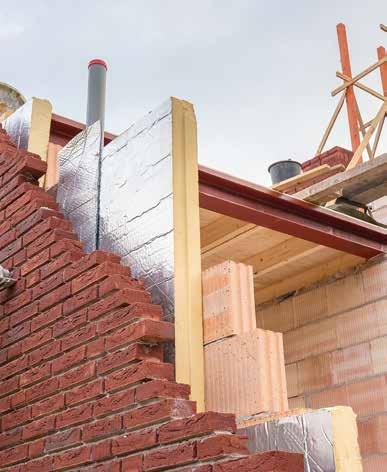






















































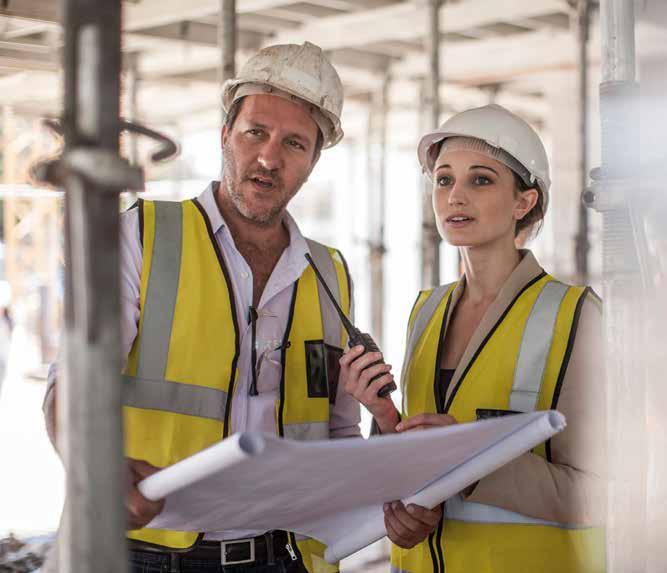
The Irish homebuilding sector faces the challenges of rising demand, reducing costs and nding greater e ciencies. Modern Methods of Construction (MMC) can prepare it to deal with labour shortages and material costs while accelerating the pace of constructing new homes.
Enterprise Ireland has a range of grant and advisory supports focusing on productivity, digitalisation and innovation, to help the Construction Industry continue to innovate to build new homes. Through MMC, we can achieve the aims of the Government’s Housing For All plan.
Get the support you need to build homes smarter, leaner and faster at: enterprise-ireland.com/builttoinnovate or speak to one of our specialist construction advisers.
BuiltToInnovate
An initiative of Enterprise Ireland under the Housing For All Plan.














many people working together collaboratively.”
Keith O’Flynn (KO’F), Sisk’s Group Supply Chain Sustainability Manager, emphasises the impact of supply chains on a project’s embodied carbon.
KO’F: “Sisk identified that 98% of our emissions come from our supply chain, making it the key focus for decarbonisation. Many suppliers lack the knowledge we have, so we’re helping them understand carbon reduction, sustainability, and social values. The Supply Chain Sustainability School, where Sisk is a founding partner, offers free resources on carbon reduction, circular economy, and biodiversity.
“Concrete, for example, is our largest emissions contributor, so we’ve created a lower-carbon concrete working group. We collaborate with manufacturers and support research in Trinity College Dublin and Construct Innovate to help reduce emissions. We are also carrying out similar work around our steel requirements.
“Plastics are another focus in our 2030 Sustainability roadmap, notably eliminating single-use plastics (SUPs) on sites. On a recent data centre project, we piloted a SUP-free waste stream, using a plastic management plan and partnering with social enterprise Responsible Plastic Management, and engaged an Offaly-based manufacturer, Waste Matters, to repurpose the segregated plastics into on-site items such as planters and posts. Waste Matters also refabricated polystyrene packaging, which is 98%air, into insulation briquettes.”
“As a result of this work, Sisk became the first company in Ireland and the UK to achieve ISO-verified Zero Plastic to Landfill certification. We’re currently investigating insulation waste solutions with several insulation suppliers.”
The Ukrainian Rapid Modular Housing (URMH) project, on which Sisk was the Design & Build lead, had the contractor bring together a team of Irish off-site manufacturers to deliver 3D volumetric homes on 11 sites across the country. MMC Integration Lead Sarah Melody (SM) says a vital element of the project’s success was creating the circumstance for these manufacturers to collaborate.
SM: “The URMH project came to us through the emergency legislation that the government passed to provide housing for the Ukrainian refugees arriving in Ireland. The OPW, as the client, ran that project from the beginning with expediency and a focus on quality.
“Sisk came on board as the D&B contractor, bringing in our supply chain. We worked with the OPW, our design team and the OPW’s cost consultants to demonstrate value for money. Getting this initial collaboration alignment was essential.
“We then went to our supply chain to make sure we had the capacity within the country to deliver these homes in the right time frame. We did this on an open tender, with 14 companies tendering. We reduced this to a shortlist of six, then brought those companies together and told them they were all successful and would have to find a way to collaborate to ensure each manufacturer was delivering the exact same unit to site.
“The manufacturers were fantastic from the start. They took the consistency piece on board, sharing fire details, jointing details, framing, etc. It was a massive collective effort, and it worked. This showed that the construction supply chain in Ireland, which is often described as fragmented and lacking capacity, was able to collaborate and support each other. In a wider context, they also showed their potential to help address our future housing needs.”
JM: “On the URMH project, we conducted As Designed and As Built studies. We learned the coordinated offsite programme resulted in an 80% reduction in waste against a traditional build

programme with similar carbon emissions reductions.”
SM: “We took a similar approach with our national PPP Community Nursing Project with the HSE. Sisk is building seven community nursing units across the country with precast reinforced concrete frames. To meet programme, we ensured that all ventilation, drainage, electrics panels and elements such as pendent hoists were coordinated early before the manufacturer fabricated the panels.”
CK: “The coordination was all done through BIM with all services and fixed furniture modelled and agreed before we installed on site.”
JM: “Modular presents huge opportunities for the re-use of materials down the line. Once a building has reached the end of its life cycle, it can be deconstructed rather than demolished, and the individual elements will have value for other projects without carbon costs.”
In closing the conversation, Juan A Morillas makes a salient point that no matter what a person’s function is within an organisation, particularly in a large organisation, or project team, they need to be able to collaborate and have the tools in place to facilitate collaboration.
JM: “We have got to a point where we work seamlessly together despite being in different departments and locations at times and reporting up different lines. The new offices bring collaboration to another level, whether that is using the technology of the building or simply having a work environment that makes people more accessible. The building is optimised for us all to make the most of our work.
“We also have organisation systems in place that ensure we have the data and information we need to do our jobs and can share this information with colleagues, clients or supply chain members. Collaborating in this way makes for better project delivery and helps remove carbon from the construction process,” Juan A Morillas concludes.

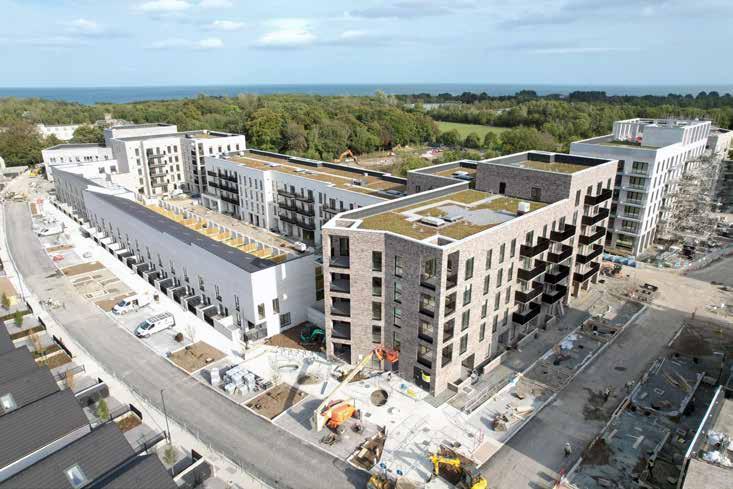

An Taoiseach Simon Harris and Housing Minister Darragh O’Brien have officially opened Shanganagh Castle Estate, a joint project by the Land Development Agency and Dún Laoghaire-Rathdown County Council.
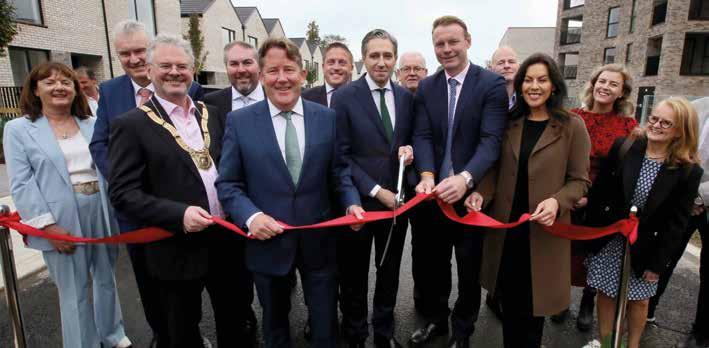
Taoiseach Simon Harris and the Minister for Housing, Local Government and Heritage, Darragh O’Brien, officially launched the first new homes at Shanganagh Castle Estate in Shankill, Co Dublin.
The development, delivered by the Land Development Agency (LDA) and Dun Laoghaire-Rathdown County Council (DLR), ahead of time and on budget, is the largest public housing project in years.
It is also the first of a pipeline of around 20 housing projects to be completed by the LDA on state-owned land. It follows the completion of well over a thousand homes from a series of partnerships with other housebuilders.
When completed, Shanganagh Castle Estate will comprise 597 high-quality houses and apartments, including affordable purchase, cost rentals, and social homes.
In addition to the Taoiseach and housing minister, Cllr Jim O’Leary, Cathaoirleach, DLRCC; John Coleman, CEO, LDA; Frank Curran, CEO, DLRCC; and Cormac O’Rourke, Chair, LDA, were in attendance.
Taoiseach Simon Harris said: “I am delighted to be in Shanganagh to launch this fantastic housing development and particularly pleased to see the mix of high-quality, affordable purchase, cost rental and social homes. The government
is investing significantly in increasing the supply of affordable and social housing, and it’s great to see this funding is being used to deliver not just new housing but new facilities, amenities and, ultimately, new communities. As Taoiseach, housing is my number one priority, and the delivery of affordable housing developments on state land like this is a testament to what we can achieve. This new development is superbly located and completed to the highest construction and environmental standards. I would like to congratulate the LDA and DLR on what has been achieved here, and I look forward to visiting again to meet the new residents of Shanganagh Castle Estate.”
Minister O’Brien said: “In November 2022, I had the pleasure of turning the sod on this momentous development. To be back here less than two years later, officially launching the first of the homes for sale, is just fantastic. To see what has been achieved in such a relatively short space of time is incredible. This is the first affordable housing development to be directly delivered by the LDA on state-owned land, and it will soon be followed by many others. The LDA has already delivered a series of top-quality, affordable homes by partnering with developers under Project Tosaigh, and considerable progress is now being made on state-owned sites, in partnership with DLR in this case. A greater supply of
affordable housing is a key element of the government’s Housing for All plan, and delivery is ramping up significantly. I would like to congratulate both the LDA and DLR as well as everyone involved in making this new housing development a reality.”
LDA CEO John Coleman said: “Shanganagh Castle Estate is a highly significant development for the LDA. It’s the largest public housing project in recent years and our first affordable housing development to be directly delivered on state-owned land. It’s also a great example of the LDA’s expertise, our design standards and our vision. Working closely with our partners, DLR, and our contractors, Walls Construction, we have been able to complete the first of 597 homes in just under two years of active construction. We are extremely pleased to be making these new homes available at affordable prices for buyers and affordable rates for renters. This is a major achievement for the LDA, but it is just one of a growing number of affordable housing developments we are working on. I would like to thank the government for ensuring we are adequately funded to invest in such high-quality projects, and given the significance of today, I would like to thank the staff of the LDA. Their hard work and commitment got us to this point and will continue to ensure we deliver on our important remit.”

Walls Construction is delivering the LDA’s and DLR’s Shanganagh Castle Estate in Shankill, one of the largest and the most sustainable social housing project in the state’s history.
As the Design & Build main contractor on Shanganagh Castle Estate for the Land Development Agency (LDA) and Dun Laoghaire Rathdown County Council (DLR), Walls Construction leveraged the benefits of early contractor involvement to streamline the entire project delivery process. By engaging with the client, architects, contractor, and supply chain early in the project, Walls facilitated a collaborative approach that has enabled all parties to work together effectively from the outset. This proactive collaboration has helped ensure the smooth and efficient progression of the project.
From the beginning, Walls assumed responsibility for fostering seamless collaboration across the project team and maintaining strong stakeholder engagement. To achieve this, the main contractor developed a comprehensive project plan. A crucial part of this approach includes regular coordination meetings, particularly weekly sessions with the design team, to keep the project on track and address any emerging issues in a timely manner.
In addition to internal coordination, Walls has implemented a structured engagement process with external stakeholders, including LDA, DLR, local community groups, businesses, councillors, and other relevant third
parties, such as DLR’s biodiversity officer. This engagement was formalised through a detailed engagement plan that incudes pre-commencement presentations, continuous updates, the appointment of liaison officers, and ongoing meetings with stakeholders. The success of this structured and inclusive approach is reflected in the smooth progression of the project, which has involved complex challenges such as extensive landscaping and the integration of various communal facilities.
Sustainability is a central focus throughout
the project, with Walls Construction incorporating environmentally conscious practices at every stage. One of the standout sustainability features of the project is the innovative approach to stabilising and reusing on-site soil.
By lowering road and parking levels by approximately 900mm, Walls has been able to excavate and store subsoil at a designated soil stabilisation mixing and screening area. Using a screening machine, large stones and unwanted materials are filtered out, and the remaining subsoil is mixed with cement and water at a specific ratio. This mixture is then stored for reuse on site, where it is




incrementally compacted to raise roads and parking levels.
The entire process is being monitored through California Bearing Ratio (CBR) tests to ensure the stabilised subsoil meets the necessary strength specifications.
To further protect the stabilised subsoil, a 300mm layer of capping stone has been added. Through these measures, approximately 10,000 cubic metres of subsoil has been reused on-site to date, significantly reducing waste and avoiding the need to transport the soil off site. Additionally, the project avoided the delivery of over 1,200 loads of stone, resulting in a substantial reduction in transportation-related carbon emissions.
In parallel, during the demolition of existing dwellings on the Shanganagh
site, Walls took a sustainable approach by crushing concrete floor slabs and block walls. This process resulted in the production of over 800 cubic metres of material, which was repurposed for temporary walkways, further reducing waste and the need for new materials.
Walls Construction has prioritised biodiversity throughout the project, particularly in relation to the extensive landscaping and public realm works. This included the restoration of an existing pond within the historic grounds, the creation of playground areas, and the construction of new pedestrian and cycle paths connecting to future transportation hubs, such as the proposed Woodbrook Dublin Area Rapid
Transit (DART) station.
Working in a live pond area, home to various known amphibian and plant species, presents significant environmental challenges. To address this, Walls is collaborating with ecology professionals and liaising closely with DLRCC to put detailed environmental protection measures in place, ensuring that the local ecosystem is preserved throughout the construction process.
Throughout the project also the implementation of modern construction methods are playing a crucial role in driving both efficiency and quality. Walls are employing Lean Construction principles to minimise waste and enhance collaboration among the project team. By reducing inefficiencies and focusing on continuous improvement, Lean Construction has helped keep the project on track while promoting a more productive working environment.
Additionally, Walls has integrated modern methods of construction (MMC) into the project to improve precision and speed up the building process. MMC, particularly the use of offsite precast concrete manufacturing in controlled environments, is significantly contributing to reducing health and safety risks by limiting the number of personnel involved in potentially hazardous on-site operations. This approach has not only improved safety but also allowed for tighter control over quality and reduced the environmental impact of on-site activities.
A key innovation in the project is the use of Takt planning, a production scheduling method designed to align project workflows with customer demand. This approach ensures continuous and efficient progress by improving communication between different project stakeholders. Unlike traditional planning methods, which often rely on specific individuals with detailed knowledge of particular tools, Takt planning facilitates transparency and enables easier adjustments to the project schedule. As a result, the team can effectively plan for materials and manpower, avoid delays and maintain progress within planned timelines.
Walls Construction’s strategic use of early contractor involvement, sustainable practices, biodiversity preservation, and modern construction methods has resulted in a project that is not only meeting but exceeding its objectives. This integrated approach has set a benchmark for future developments, particularly in the areas of sustainability, efficiency, and collaboration.
Houses delivered in Phase 1 of the Shanganagh Castle Estate development.
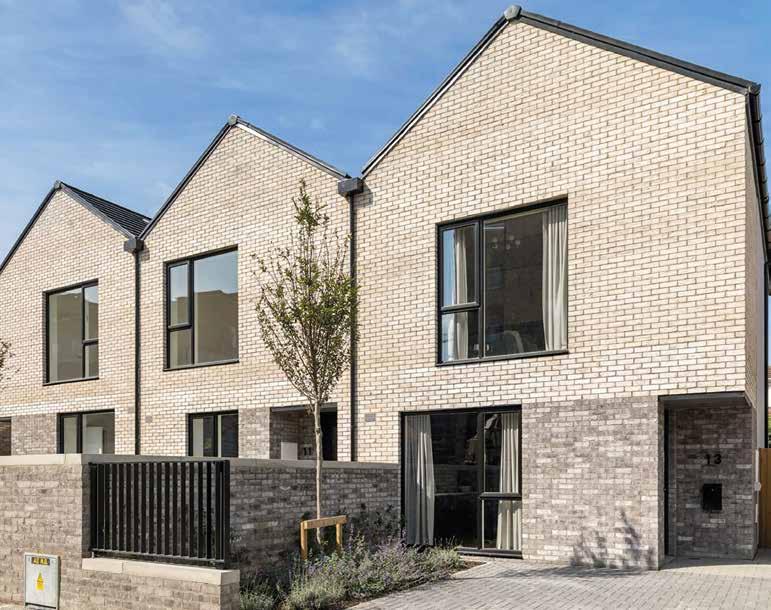
Shanganagh Castle Estate is an affordable, sustainable community being jointly delivered by the Land Development Agency (LDA) and Dun Laoghaire Rathdown County Council (DLR) with Walls Construction as the appointed Design & Build main contractor.
The architectural team comprises DLRCC Architects office, ABK Architects and O’Mahony Pike Architects.
The LDA and DLRCC partnership will ultimately deliver 597 homes on land owned by the local authority. The breakdown of units is 51 houses, 546 apartments, creche and play area, with retail and other community facilities.
Construction of the development commenced on site in September 2022. The delivery of the project is running on time and within budget.
The schedule for delivery is as follows:
• Phase 1: 51 houses and creche facility – September 2024.
• Phase 2: Blocks A, B, C and D, 230 apartments – November 2024.
• Phase 3: Blocks E and F, 144 apartments – March 2025
• Phase 4: Blocks G and H, 172 apartments – August 2025.
The tenure split is:
• 51 affordable purchase
• Block F 40 units affordable purchase
• Blocks A, B , C & G 306 units cost rental


An Taoiseach Simon Harris and LDA CEO John Coleman discuss progress on the Shanganagh Castle Estate development.
• Blocks D, E & H of 200 units for social housing.
The overall development will have 340 car parking spaces, 38 of which are prepared for EV charging, with the remainder ducted for future use, 14 motorcycle spaces, and 1,400 bicycle spaces.
The homes at Shanganagh Castle Estate will be 100% affordable, with 51% cost rental (306 homes), 15% affordable purchase (91 homes) and 34% social housing (200 homes). The development offers a mix of accommodation suitable for single people, couples and families, with 99 of the new homes to have three bedrooms.

The project was tendered as a Design & Build project, a tender which was won by Walls Construction Ltd. The clients and project team took a collaborative approach from the early stages, designing the blocks in precast concrete with numerous other prefabricated elements.
This brought the advantage of having standardised formworks systems with a reduction in on-site labour and fewer deliveries to site.
The early engagement also facilitated window and door openings and services being incorporated into the panels, resulting in no requirement for on-site cutting or drilling.
Other forms of offsite construction came from mechanical and electrical services, balustrades and balcony systems.
A stabilisation process is being utilised to enable the reuse of excavated materials in the formation of the roads.
The on-site waste management plan includes segregating any waste on site for repurposing.
There is also a strong emphasis on biodiversity and ecology to maintain and support existing plant and wildlife on the site. On completion, the goal is for the scheme to have a net positive impact on biodiversity in the area with actions being taken to rehabilitate any affected species/landscapes.
The six apartment blocks will be topped off with green roofs.
The first phase of Shanganagh Castle Estate is not only the first major direct delivery project to be completed by the LDA, but it will be one of the largest certified Passive House urban schemes in Europe.
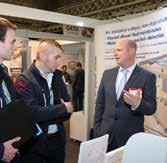
Infrastructure • Services • Solutions
DataCentres Ireland combines a dedicated exhibition and multi-streamed conference to address every aspect of planning, designing and operating your Datacentre, Server/ Comms room and Digital storage solution – Whether internally, outsourced or in the Cloud.
DataCentres Ireland is the largest and most complete event in the country. It is where you will meet the key decision makers as well as those directly involved in the day to day operations.
EVENT HIGHLIGHTS INCLUDE:
Multi Stream Conference
25 Hours of Conference Content
International & Local Experts
60+ Speakers & Panellists
100+ Exhibitors
Networking Reception


Entry to ALL aspects of DataCentres Ireland is FREE
• Market Overview
• Power Sessions
• Connectivity
• Regional Developments
• Open Compute Project
• Heat Networks and the Data Centre
• Renewable Energy
• Standby Generation
• Updating Legacy Data Centres


Now in its 15th year, DataCentres Ireland has built a reputation locally and internationally for the quality of attendees it delivers, its professional atmosphere and the networking opportunities and subsequent business that comes from meeting a qualified target group of industry leaders, decision makers and specifiers.
Comprising of an Internationally respected Multi-Streamed Conference integrated into a major international Exhibition –DataCentres Ireland is a unique opportunity to meet your market, discuss their needs and forge lasting and valuable business relationship that will benefit you and your business.
Anyone involved in/or responsible for their organisation’s critical infrastructure, where continuity of service is a must… Whether this is a Data Centre, IT Comms Room, Industry or Commerce.
Attending DataCentres Ireland 2024 is not just about staying current; it’s about staying ahead in a rapidly evolving industry. Whether you’re looking to improve operational efficiency, network with industry leaders, or explore new technologies, this event offers something valuable for everyone in the data centre sector.
The conference features a strategy and operational stream, one looking at the issues driving the market, the other on the technologies and practices which can be employed to make the design, building and operation of new and existing data centres more effective and efficient.
The conference includes how data centres can help grow the Irish economy and use the latest best practice, products and technologies, to make data centres more sustainable, achieve greater carbon reduction and improve efficiency, as well as assisting in the adoption of green energy onto the Irish grid.

The conference programme can be viewed at www.datacentresireland.com.
For over a decade, DataCentres Ireland, has consistently delivered a quality audience of decision makers and specifiers responsible for the Irish data centres sector and beyond.
The Exhibition is your opportunity to showcase you, your company, and the products, services, technology and solutions you offer to all involved in the sector in just two days!
With only eight stands remaining secure your stand today, or register to attend for free, call +44 1892 570513 / email datacentres@stepex.com or visit www.datacentres-ireland.com
MMD Construction delivered a multi-awarding winning innovative sustainable housing development for Tuath Housing Association and Cork City Council.
Springville House’s evolution from a derelict 1970s office block into a vibrant residential complex in Cork city centre is a testament to the power of innovation, collaboration, and sustainable development.
MMD Construction was the main contractor, PSCS and design lead for the works at Springville House, Blackrock. The development comprised the change of use of Springville House from a former multi-storey office building to a residential accommodation scheme for the Cork City Council and Tuath Housing Association.
The innovative and sustainable development for older adults wishing to ‘right-size’ their accommodation requirements will help contribute to alleviating pent-up demand for housing in Cork city.
The works included partial demolitions and construction of extensions to the north and east, and the construction of a third floor to the building. The project provides 35 residential units consisting of;
• Four one-bedroom, single-storey houses
• 13 two-bedroom apartments
• 18 one-bedroom apartments
• Alterations to existing car parking surface
The ambitious redevelopment project not only addressed the pressing need for affordable housing in a high-demand area of Cork city but also exemplified a commitment to environmental responsibility and community engagement.
Central to the success of Springville House was the innovative approach taken by Cork City Council in utilising the EU Competitive Dialogue procurement process. This process facilitated open dialogue with potential bidders, architects, and local communities from the project’s inception, and stakeholders were able to provide valuable insights that shaped the development into a right-size scheme tailored to the specific needs of its future residents.
The adoption of modern construction techniques and energyefficient design principles bolstered the project’s sustainability credentials. Through the use of light gauge steel systems and environmentally-friendly materials, the building’s structural integrity was enhanced and its carbon footprint was minimised. Additionally, the incorporation of air-to-water heat pumps and high-quality insulation resulted in A-BER certification, ensuring optimal energy efficiency and reducing operational costs for residents.
With Springville House, sustainability extended beyond the physical infrastructure to encompass social and community development. By fostering a sense of community and providing spaces for interaction and engagement, the project aimed to combat social isolation and promote well-being among residents.
The concept of right-size living offered tailored solutions to meet the diverse needs of its residents, further enhancing the project’s



social impact.
The client, Tuath, acknowledges the profound impact that sustainable building practices can have on people, places, communities and the environment. It is committed to seeking innovative ways of providing homes while strengthening the partnerships necessary to elevate its commitment to sustainable, resilient, and environmentally friendly housing solutions.
Tuath’s vision for a greener future shapes its approach to sustainable housing initiatives. Springville House is the perfect example of urban revitalisation, innovation, and sustainable development.
By embracing collaboration, harnessing innovative procurement processes, and prioritising the well-being of its residents and the surrounding community, the project has set a new standard for future developments.
Formerly a vacant and dilapidated building, Springville House has been transformed into a modern, A-rated residential development by MMD Construction. The project involved converting the four-story structure into 35 units, including one- and two-bedroom apartments and townhouses.
Funded by the Cork City Council’s ‘Rightsizing’ programme, the development aims to provide suitable accommodation for residents aged 60 and over. The units feature modern amenities, including large windows, separate living and kitchen areas, and outdoor balcony spaces. Additionally, the development includes shared storage areas, bicycle sheds, and accessible outdoor space.
The Design & Build project involved significant demolition, new extensions, and the addition of an extra storey. Internal and external

walls were removed, and existing glazing and mechanical fixtures were replaced. A light gauge structural steel frame for the extensions and top storey was manufactured offsite. The building now features aluminium frame windows, external doors, and curtain walling housed in a stylish brick and plaster finish. The heating system uses exhaust air from the venting system, a popular solution in modern apartment construction.
Building on a brownfield site posed challenges, including limited access due to the proximity of a busy road, housing estate, and school. The site constraints required careful scheduling of deliveries and coordination with local stakeholders to minimize disruption. Additionally, the design had to adapt to maximise space within the existing structure while ensuring compliance with modern building regulations. Low ceilings and drop beams limited the space available for mechanical and electrical installations.
While the project faced obstacles due to the site’s constraints and the need to adapt to existing structures, MMD Construction overcame these obstacles through innovative design and construction techniques. The use of high-tech scanners and modular construction methods helped to ensure the project’s efficiency and sustainability.
The Springville House development is a flagship for Cork City Council’s ‘Rightsizing’ initiative. It provides high-quality accommodation in a prime location and is expected to inspire future projects across Ireland, offering solutions to housing challenges for both older residents and young families. MMD Construction hopes to continue collaborating with the Cork City Council on similar projects.
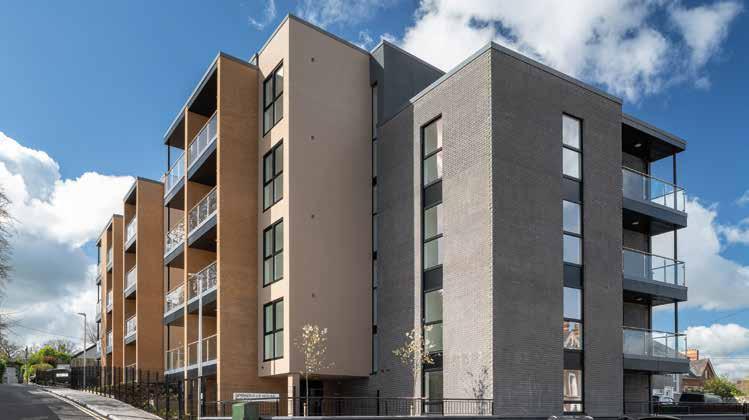


A good construction claim submission should flow and be easily understood. PETER MCCARTHY, Principal, Conlex Consulting, writes that quality, not quantity matters and that you should never include irrelevant information.
As a claim consultant, I often get asked for advice on how to formulate a construction claim or asked to review claim submissions to improve their chances of success. I understand that sitting down to start drafting a construction claim can be daunting, often not knowing where to start. To support you in this task, I have put together some key points to consider, which I am sure will set you on the right track.
Very often, the receiver of a claim submission may not be too pleased when it lands on its desk, and the document could quickly find its way well down the receiver’s to-do list. Therefore, when presenting a claim, you must make it as easy as possible for the receiver to review it. Well-presented, well-structured and userfriendly claim submissions will go a long way to achieving this. Claim submissions should ideally be presented in two volumes where:
• Volume 1 will contain the story or narrative of the claim, which deals with the project, sets out the circumstances of the claim, demonstrates the effects of the claim and outlines the basis of any supporting documents that have been included to demonstrate the effects and quantum of the claim.
• Volume 2 will include appendices containing supporting documents referred to above, such as project records, correspondence, programmes, photographs and the like.
The advantage of presenting the claim in this format is that the reviewer can read the narrative and the supporting information side by side, making it easier for the reviewer to digest what is being said.
As the saying goes, ‘don’t judge the book by the cover’, but very often, that is what a reviewer will do when presented with a claim. So, if the claim is poorly put together, the submission is off to a poor start in convincing the reviewer that the claim’s author is professional and the content is credible. To be judged professionally, a submission must:
• Have a good quality, professional-looking cover
• A contents page that helps the reviewer quickly navigate its way around the document
• Include an element of signposting explaining to the reviewer the format of the submission
• Clearly labelled tabs and dividers to separate the various sections and appendices to make the claim easily and quickly accessible
• Spacious layout to allow the reviewer to take notes as it digests the content
• Easy-to-read font
• Headers and footers containing the relevant party names, document names, page numbers, and date (if necessary)
• Ensure the various sections of the submission are sequenced logically, clearly identifiable and correctly cross-referenced to each other.
Following a well-presented claim submission, the narrative must be drafted in a way that’s easy for the reviewer to read and understand. The following are some points that should be considered:
• A good claim submission should flow and be easily readable and understood. It needs to have a beginning, a middle and an end.

The beginning will set the scene for the reviewer by explaining the background of the project and the general circumstances relevant to the claim. The middle explains the event that has occurred, the cause of the event, its effect, and where you are entitled to relief under the contract. The ending will be a logical conclusion in which relief under the contract and quantum are summarised, explaining to the reviewer what the outcome of the claim or response should be. Failure to correctly arrive at a logical conclusion could result in the reviewer arriving at its own conclusion that might not be in your favour.
• The use of abbreviations should be avoided, or if used, their meaning should be explained when first used. It is safer to assume that the reviewer will not understand an abbreviation that you have regularly used during the course of a project. Should the claim submission get referred to someone beyond the reviewer, i.e. a dispute resolver, that person will not understand the meaning of abbreviations without meaning.
• Avoid legalistic language. Be mindful of your audience, who may not have a legal background. The use of this type of language can negatively impact understanding of the narrative. It is better to keep the language simple and to the point.
• Avoid ambiguities. For example, when referring to the various parties involved in the project, rather than referring to them as ‘them’ or ‘they’, it is better to refer to the parties in the same way as they are referred to in the contract, such as Employer, Contractor and Employer Representative/Architect etc. The same applies when mentioning various contract documents, i.e., drawings and specifications, etc.
• Use quotations in the narrative for maximum impact. For example, if referring to extracts from the form of Contract to prove entitlement, include this extract as a quotation to add more weight to the point you are trying to get across.
• Don’t rely on other documents to tell your story. Don’t draft your claim in a way that the reviewer has to shift through large quantities of other paperwork to understand your argument. It is essential the claim submission is read and understood without making constant reference to other documents. A reviewer who is forced to refer to other documents will quickly
lose interest in the claim and will not be predisposed to your argument. Make it as easy as possible for the reviewer to follow your argument.
• Beware of information overload. Following on from the above point, when referring to other documents in your narrative, ensure that only the essential information from the document is reproduced. For example, if referring to a letter, seek to paraphrase its contents within the narrative rather than quote the entire letter. A copy of the letter can be included in the appendices, and the narrative can include a cross-reference to its location so that the reviewer can examine the remaining content should it so wish. Lazily dumping whole extracts of other documents will cause the main points of your story to be lost and serve to disinterest the reviewer.
On receipt of a claim submission, if a reviewer cannot find the documents you refer to or has to request additional information to better understand your case, the reviewer will not be well disposed towards your submission. More so, if the submission was being reviewed as part of a dispute resolution process, the dispute practitioner may well take the view that a failure by you to include such documentation means that your claim has not been substantiated, and the dispute practitioner may well reject your claim. For that reason, it is important that your claim submission includes everything that the reviewer will need to determine the merits of your claim.
When drafting your claim submission, and to ensure the submission stands on its own two feet, ask yourself, ‘Could someone with absolutely no knowledge of the project and the issues complained of fully understand it?’. While the claim document may be going to someone who has prior knowledge of the issue[s], the claim submission may well get transferred up the line to others within or outside an organisation who will have difficulty understanding the argument being made if all documents being referred to in the narrative are not included.
Your appendices should, therefore, include items such as:
• Project records referred to in the narrative, i.e. photographs, allocation sheets, etc.
• Copies of all correspondence referred to in the narrative
• Programmes used to support your case
• Copies of drawings referred to in your narrative
• Relevant extracts of the form of Contract relied upon
• Calculations used to back up your quantum and copies of invoices to substantiate prices claimed
• Minutes of meetings referred to in the narrative
• Relevant extracts of the specification referred to in the narrative
Remember, it’s quality, not quantity. Avoid including irrelevant information. Getting the reviewer to wade through large quantities of irrelevant information certainly will not make life easy for the reviewer and can only weaken your chances of success. Therefore, the claim drafter must decide what is relevant and should be used in the submission and what is not relevant and should be discarded. Information overload will weaken the message you are trying to convey and distract the reviewer from that message.
So, you’ve put together the claim document. What next?
Many professionals putting together a claim submission will have been deeply involved in the project, have lived and breathed the issues for long periods, and, in some cases, may have a strained relationship with the person tasked with reviewing the document. This can make it difficult for the claim drafter to notice what is important about the issue being complained of, where they can’t see
“If the claim is poorly put together, the submission is off to a poor start in convincing the reviewer that the claim’s author is professional and the content is credible”
‘the wood from the trees’ or have assumed that the reviewer has the same knowledge as them about the issues. This could result in the claim drafter failing to clarify matters and missing out on minor but essential information.
When the narrative and supporting appendices are complete, it is, therefore, prudent to have an independent observer review the submission. This person should have:
• Little or no knowledge of the issues complained of and,
• Ideally have the professional expertise to understand and advise on improvements to be made to the submission.
This independent observer should:
• Put themselves in the shoes of the reviewer and,
• After reviewing the draft submission, advise the author on unclear sections of the submission, incorrect grammar, inappropriate language, unsubstantiated statements and the like.
• Check that the supporting documentation in the appendices is correctly referenced in the narrative
• Ensure that the narrative correctly explains the significance of the supporting information and
• Ensure that cross-referencing between the narrative and the supporting appendices is correct.
Proofreading the claim submission yourself should be avoided, as you will be inclined to read what you think you have written rather than what you have actually written. Getting your claim document proofread by an expert independent observer will ensure you have a submission the reviewer can clearly follow and understand, thus increasing your chances of success.

Peter McCarthy holds dual expertise in Quantity Surveying and Construction Law and is the founder and owner of Conlex Consulting, which supports clients with pre-contract review, postcontract support, preparation and negotiation of claims, dispute avoidance and dispute resolution. Peter is a fellow member of the Society of Chartered Surveyors of Ireland and the Chartered Institute of Arbitrators and is an approved Adjudicator and Conciliator on the SCSI panels.
To learn more, email peter@conlex.ie or visit www.conlex.consulting

Remote monitoring provides peace of mind 24-7.
For over 200 years, Chubb Fire and Security has been at the forefront of fire safety and security, dedicated to keeping people and properties safe. In Ireland, Chubb operates across both Northern and Southern regions. Under the leadership of Alan O’Connor, the company is supported by a team of skilled field-based engineers, dedicated sales professionals, and a robust administrative staff, all ready to serve customers nationwide and across Europe.
Chubb supports a diverse range of businesses, providing comprehensive fire safety and security solutions that protect its customers’ people, property, and assets.
Chubb offers a suite of life safety services tailored to meet the specific needs of its diverse client base. For example, in facilities such as pharmaceutical plants, the focus is on advanced fire detection and alarm systems integrated with voice alarm and public address (VAPA) solutions to ensure swift emergency response.
Chubb’s expertise extends to gas suppression technologies, such as Argonite, and gas detection systems essential in environments like laboratories where hazardous gases are present. This comprehensive approach enables clients to operate with confidence, knowing they have state-of-the-art protection in place.
Recognising the evolving security landscape in Ireland, Chubb is strengthening its local presence by enhancing its security monitoring capabilities and expanding operations in key regions such as Dublin and Cork.
By integrating fire safety with advanced security solutions - like access control systems, surveillance technologies, intrusion detection, and remote monitoring - Chubb provides a holistic approach to safety. This one-stop, trusted provider model offers customers unparalleled convenience and peace of mind.
Chubb has an unwavering focus on building and nurturing relationships, underpinned by a commitment to delivering exceptional service throughout the entire lifecycle of its systems and solutions.
Unlike companies that take a transactional, cost-driven approach, Chubb invests deeply in its customers’ success. From initial design and installation to



ongoing maintenance and support, Chubb prioritises forming lasting partnerships.
Chubb’s track record of long-standing partnerships includes working with leading pharmaceutical companies for several decades. One notable biopharmaceutical customer has relied on Chubb for nearly 20 years to provide, install, and maintain fire alarm, gas detection, and life safety systems across multiple sites.
Recently, Chubb identified an opportunity to enhance this customer’s fire safety system. With the obsolescence of analogue systems and the rise of digital solutions, Chubb recommended a significant network upgrade. This included installing a fibre optic cable network, updating fire panel network cards, enhancing fibre optic enclosures,
and relocating hard-to-access fire alarm panels. Upon completion, the customer benefitted from round-the-clock remote monitoring and a reduction in system faults and downtime.
Chubb has also been a key partner for Mahon Point Shopping Centre, Cork’s largest retail complex. Since its opening in 2005, Chubb has provided vital life safety solutions, including a fire detection system, voice alarm system, gas detection system, fire telephone system, and sprinkler interface system, all integrated through a Notifier ID3K system. This setup allows for immediate hazard location pinpointing via the ONYXWorks graphics system, ensuring rapid response by security teams.
The initial installation was completed within a tight schedule in December 2004,
with ongoing maintenance conducted quarterly. Chubb’s regular servicing guarantees the life safety systems operate in peak condition, minimising the need for additional site visits, except when reconfiguration is required for new retail units.
Chubb is gearing up for an exciting 2024 and 2025, providing security solutions for high-profile projects, including several data centres across Europe.
This evolution has been about rebuilding the brand, reinforcing its core values, and making strategic decisions that propel the company forward.
What sets Chubb apart is its collaborative approach, not just within the Irish operations but across the broader Chubb network. By breaking down silos and fostering collaboration between teams, Chubb leverages its collective expertise to seize new opportunities.
Moreover, Chubb’s commitment to continuous training and development is equally remarkable. Investment in employee training, certification programs, and professional growth ensures that its teams stay at the forefront of industry trends and technological advancements. This dedication empowers Chubb employees to deliver outstanding results for customers, ensuring that safety and security remain at the heart of every project.
In the end, it’s about more than just providing solutions - it’s about making the world a safer world, one customer at a time.
For more information about Chubb’s services and solutions, please visit www.chubb.ie


Construction Information Services (CIS) provides an overview of some of the residential projects currently under review as well as key developments that have recently broken ground.
Ireland’s housing market is undergoing a period of transformation as developers continue to respond to the growing demand for residential units. In recent months, several large-scale residential developments have been submitted for planning approval across the country, marking a significant push to address the ongoing housing shortage.
While rural areas see slower growth in property prices, there is growing interest in picturesque areas or those close to cities. However, rural development remains constrained by limited infrastructure and fewer job opportunities, creating an affordability gap that is particularly acute in urban centres like the Greater Dublin Area (GDA).
While the Irish government has implemented measures such as the Help to Buy scheme for first-time buyers and initiatives to promote higher-density developments in urban areas, the construction sector is struggling to meet the surging demand. Issues such as skills shortages and rising materials costs continue
to hamper the speed and volume of new home developments.
Landlords have been exiting the rental market due to increasing regulations and lower returns, further tightening the already stretched rental market. This has pushed rents to new heights, with fewer mortgage approvals for residential investment lettings exacerbating the issue.
Despite historically low interest rates keeping mortgage demand strong, potential future increases could impact affordability, slowing down the housing market and cooling buyer demand.
The Irish government has introduced several initiatives to address the housing shortage. One of the most impactful is the temporary waiver on development contributions under the Planning and Development Act 2000. This policy has stimulated a notable increase in house starts, with CIS reporting a 660% rise in house starts as of April 2024 compared to the previous year.
In the landscape of recently submitted
planning applications, several large-scale residential developments stand out. One project is a €38m residential development in Dunboyne by Carroll Estates Dunboyne Limited, which aims to deliver 171 housing units to meet growing demand in the area.
Meanwhile, Marshall Yards Development Company Limited has proposed a €36m project in Balbriggan, with 197 residential units complemented by open spaces and essential infrastructure.
In Cork’s Little Island, Ruden Homes has submitted a €36m mixed-use proposal for 172 residential units, including houses, duplexes, and apartments, alongside community amenities such as a creche. If approved, these plans will play pivotal roles in alleviating the housing pressures in their respective areas.
Among the most significant recent approvals is Glenveagh Homes Limited’s €71m project at Ballymastone, Donabate, Dublin, which will introduce 364 residential units. This ambitious development aims to tackle Dublin’s housing demand by offering a mix of houses, duplexes and apartments


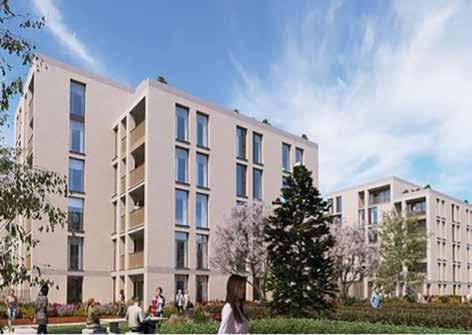
alongside ample green spaces for community living.
In Waterford, Monaco Limited has received the go-ahead for a €52m development on the former Waterford Crystal Sports and Leisure Centre site. The project, which includes 292 residential units and a standalone creche, is set to revitalise the Cork Road area, providing both housing and local amenities.
Work has commenced on several large-scale schemes that will shape Ireland’s housing landscape. In Dunboyne, Co Meath, the development of 155 houses and two duplex blocks marks the beginning of a larger project that will eventually deliver over 700 units. Similarly, in Dublin, Cairn Homes Plc has started construction on 268 Build-toRent apartments at Northwood Crescent in Santry Demesne, offering modern amenities like shared workspaces and rooftop terraces.
The ongoing housing crisis in Ireland is not limited to urban areas. Rural regions, while experiencing lower demand, also face challenges such as underdeveloped infrastructure and a lack of job creation. Looking ahead, the government’s ambitious Housing for All plan aims to deliver 33,000 new homes annually. While a promising initiative, some estimates suggest that more than 50,000 homes per year may be needed to address Ireland’s chronic housing deficit.
Dave Thompson, Commercial Director CIS, comments: “The housing market in Ireland is at a critical juncture. Despite promising developments and government intervention, issues of affordability, supply, and economic stability will continue to dominate the conversation.
“As urban centres face growing demand and rural regions seek investment, the effectiveness of ongoing initiatives will be key to stabilising the market and ensuring Ireland’s housing needs are met.”
Construction Information Services (CIS) has been providing reliable, verified, and real-time insight and intelligence on the Irish construction sector for more than 50 years. The Irish market leader’s research teams, based in Banbridge and Dublin, combine ongoing outbound outreach with the latest technology to deliver trusted information that helps businesses or organisations make informed decisions. Its services are used by blue-chip brands in the private and public sectors throughout the island of Ireland. CIS service subscribers can access information on around 140,000 construction projects in NI and RoI.

ERLING HAALAND OFFICIAL BRAND AMBASSADOR






Make the greener choice for your home, upgrade your existing central heating with an eco-friendly, low noise Midea Heat Pump. Air source heat pumps are the low-carbon future of home heating which integrates heating and domestic hot water into one system.
The future of heating, renewable energy is the greener, cleaner way to heat your home. Midea’s air source heat pumps are the cost-effective way to lower your energy bills and switch to a low-carbon way of heating your home.
Make yourself at home and start saving with Midea Heat Pumps.
Construct Innovate will use €5m funding for research into delivering affordable, safer, higher-quality, and sustainable housing, with €3.5m allocated for research to create building-regulation-compliant standardised design details for MMC builds.
The Department of Housing, Local Government and Heritage, in cooperation with the Department of Enterprise, Trade and Employment, has awarded €5m in funding to Construct Innovate for research to support affordable, better quality, safer and more sustainable housing.
Construct Innovate, Ireland’s national research centre for construction technology and innovation, is part of Enterprise Ireland’s industry-led Technology Centre programme, which aims to provide independent and evidence-based research through collaboration between industry members and research-performing organisations.
Construct Innovate supports and organises research initiatives to meet the demands of Ireland’s major building and investment programmes, such as Project Ireland 2040, the National Development Plan 2021-2030, Housing for All, and the Climate Action Plan 2023.
Speaking about how the funding and the research to be carried out, Prof Jamie Goggins, Director, Construct Innovate, said: “These collaborative research projects with the Department of Housing, Local Government and Heritage will address nearand long-term challenges for the housing sector, including the current shortage of housing, quality issues with some of the existing housing stock, ensuring our homes are accessible for our ageing population allowing them to live in their homes for longer and will also look at the impact of climate change on our homes. They are being led by excellent principal investigators in Construct Innovate partner institutions, the University of Galway, University College Dublin (UCD), Trinity College Dublin (TCD) and the Irish Green Building Council (IGBC), utilising world-class research facilities and expertise available in our thirdlevel institutions in Ireland. The projects will be delivered in close collaboration with the Department of Housing, Local Government and Heritage and other key stakeholders in the construction and built environment sector.”
The Minister for Enterprise, Trade and Employment, Peter Burke, commented: “I am very pleased to make this additional €5m in funding available to Construct Innovate so that it can fulfil its mandate to address key research challenges in housing.
“The increase in funding is the result of
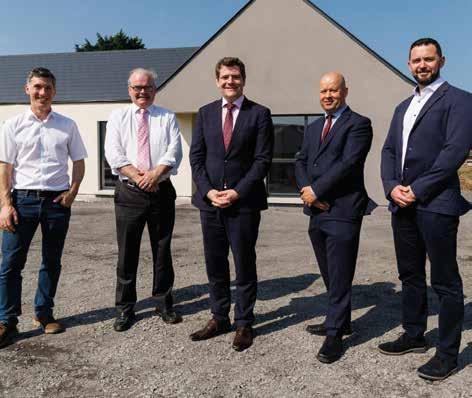
At the announcement of €5m in funding to Construct Innovate (L to r): Prof Jamie Goggins, University of Galway and Director, Construct Innovate; Neil Kerrigan, Department Manager, Technology, Infrastructure & Collaboration, Enterprise Ireland; Minister for Enterprise, Trade and Employment Peter Burke; Seán Armstrong, Principal Officer, Department of Housing, Local Government and Heritage; and Colm McHugh, Centre Manager, Construct Innovate.
by Damien Eagers.
very fruitful engagement that has included the Construct Innovate consortium, the Department of Housing, Local Government and Heritage, industry, Enterprise Ireland, and my department.”
The €5m funding will be used to deliver six projects.
The first project, ‘Creation of standardised design details for Modern Methods of Construction (MMC) builds open access to test data (structure, fire, energy and sound)’, has been awarded over €3.5m. The author of the project proposal, Associate Prof Daniel McCrum from UCD, explains: “This project aims to support continuity of MMC from design through to construction, as MMC system builds are becoming increasingly prevalent in the built environment.”
Over €800,000 was secured by the project ‘Durability of dense aggregate concrete masonry units in Irish structures – assessment of future anticipated performance – quality and safety’. This will be led by Prof Alan O’Connor, TCD.
‘Ageing population and universal access assessment – building regulations compliance assessment of universal design homes’, led by Tom Grey (TCD), will look
at the challenges people with disabilities and older people face as a result of living in housing that does not meet their needs.
‘Research into the re-use of existing buildings (including traditional buildings)’ will be led by Marion Jammet, IGBC. As part of this project, IGBC and UCD (the project partners) will review existing building regulations and technical guidance documents (TGDs), including TGD B, D, E, F, G, K, L and M, as well as their impact on building re-use in Ireland.
‘An investigation of the effectiveness of Technical Guidance Document J (TGD J) provisions regarding flue outlet locations for solid fuel-burning appliances at preventing smoke particles entering the dwelling or neighbouring dwellings’ will be led by Prof John Gallagher (TCD).
The sixth project to be supported, ‘A study to evaluate alternative methods of remediation of buildings damaged by defective concrete blocks’ will be led by Dr Myra Lydon (University of Galway). This study aims to identify the scale of the future impact of defective concrete blocks on the Irish housing stock. The existing financial support scheme will be analysed to identify socio-economic barriers to accessing remedial options.
As the construction industry embraces a digital future, the ‘Build Digital Annual Survey 2024’ offers construction professionals a chance to shape its direction. With advancements in BIM, data-driven management, and sustainability tools, full digital transformation is near. But how prepared are construction professionals?
During October, Build Digital is inviting stakeholders to share their insights, influencing future outputs and supports for the industry, whether they work on large infrastructure or smaller residential projects.
The ‘Build Digital Survey 2023’ gathered over 250 participants from industry, academia, and government to assess digital adoption in Ireland’s construction sector. It revealed a mix of optimism and challenges. While some organisations had begun integrating digital tools, others faced barriers such as costs and a shortage of skilled professionals. Key drivers for digital transformation were sustainability, efficiency, and cost reduction, though progress remained slow and complex, highlighting the need for further support.
The 2024 survey will investigate progress from 2023, exploring how the industry can better support digital adoption while addressing the real-world barriers holding some organisations back. This year’s survey will focus on several key areas:
- Compliance with national standards: As the Irish government ramps up requirements for digital integration in public projects, are organisations prepared to meet these mandates?
– Digital competence: Are professionals receiving the necessary training and resources to keep up with technological advancements? How can the industry close the skills gap?
– Future-proofing the industry: How can digital adoption increase efficiency, productivity, and competitiveness in Ireland’s construction sector?
– Sustainability and digitalisation: How are digital tools contributing to environmentally responsible construction?
By gathering insights from professionals across all levels - whether in design, construction, or project management - Build Digital will continue its mission to develop supports, inventories, and guidance documents that push the industry towards full digital maturity.
Build Digital’s annual survey is more than a questionnaire. It will help shape the future of Irish construction. Each response informs industry leaders, policymakers and training bodies on key challenges and where to invest in digital tools and skills. By participating, organisations of all sizes can help drive innovation and ensure that future tools, policies, and resources reflect the real needs of the field.
The Irish construction industry stands at a critical juncture. Digital transformation can redefine how projects are delivered, how teams collaborate, and how sustainability goals are achieved. However, success depends on the collective input of those working in the sector.
The Build Digital Survey 2024 will be launched at the Build Digital Annual Conference in Cork on 17 October 2024, and construction professionals across Ireland are encouraged to participate. Their insights will help shape the digital supports that will move the industry forward.

On 17 October 2024, Build Digital, in partnership with the National Standards Authority of Ireland (NSAI), will host its annual conference at the Radisson Blu Hotel & Spa in Cork. This event will focus on the recently introduced BIM mandate, a milestone in the ongoing digital transformation of Ireland’s construction industry.
The BIM mandate, enacted in January 2024, is now a critical part of the Capital Works Management Framework (CWMF). It signals a significant shift toward greater efficiency, transparency, and sustainability in the management of construction projects. By requiring compliance with international standards such as ISO 19650, Uniclass Classification, and Industry Foundation Classes (IFC), the mandate aims to standardise processes and improve collaboration across the construction supply chain.
The Build Digital Annual Conference will highlight advancements in digital technologies for public projects, fostering collaboration and keeping Ireland at the forefront of global construction standards. Construction professionals, especially those involved in public projects and their supply chains, will learn how to implement the BIM mandate in their organisations. The event will also showcase the latest tools from Build Digital and NSAI to help meet new standards. Through demonstrations, presentations, and discussions, attendees will gain practical strategies to integrate BIM processes and ensure compliance.
The Build Digital Conference 2024 is sold out, but there is a limited waitlist.
To join the waitlist, visit www.builddigitalproject.ie/2024-annualconference or scan the QR code
To learn more about Build Digital, see www.builddigitalproject.ie


DAVID MURRAY, Head of Technical Affairs & Ireland Sales at MEDITE SMARTPLY, answers questions about new EU regulations for classifying construction materials and how wood panel products may be viewed in future under the new EU Taxonomy for sustainable activities.
The carbon impact of the built environment comprises embodied carbon resulting from the manufacture, maintenance and disposal of the construction products that make up a building or structure and operational carbon from the type of energy or heating systems within buildings.
Timber frame is the most widely used construction method in the world, accounting for over 70% of new construction projects in the developed world globally and now 50% of the Irish market. It offers significant environmental benefits compared to traditional building materials. For example, it can reduce the whole life carbon, the full carbon impact of the built environment. It can reduce the embodied emissions in a single building by 20% to 60%. Where timber has been harvested from sustainably managed forests, timber products also act as a carbon store, locking away carbon for the duration of that product’s life (and the life of any recycled wood products made from the original product).
The European Green Deal is a policy package aimed at guiding the EU towards climate neutrality by 2050. It includes regulations such as the revised Energy Performance of Buildings Directive (EPBD) and the Corporate Sustainability Reporting Directive (CSRD), which requires companies to report on their environmental, social, and governance (ESG) impacts. The CSRD integrates the EU Taxonomy, a system for standardising sustainability criteria across sectors to define environmentally sustainable activities.
MEDITE SMARTPLY is part of Coillte, an innovative FSC-certified Irish forestry and forest products manufacturer. Based in Clonmel and Waterford. it produces a versatile range of medium-density fibreboard (MDF) and oriented strand board (OSB) building products.
David Murray, Head of Technical Affairs & Ireland Sales at MEDITE SMARTPLY, welcomes the new Green Deal and the requirement for CSRD reporting, which he believes “is a good thing for responsible manufacturers”. He adds that MEDITE SMARTPLY has been working with customers to interpret the implications of Green Deal regulations and how they might approach specifying and dealing with wood panel products under the new directives and EU Taxonomy.
“Ireland is the home market for MEDITE SMARTPLY, and being part of Coillte Group allows us to assure customers that products are responsibly sourced from dual FSC- and PEFC-certified forests in Ireland.
“Our Irish customers benefit from security of supply, safe in the knowledge that the products they buy have been grown in a local forest, have captured CO2 locally, and have a lower carbon footprint than products that have been imported.
In addition, our focus on growing in the local Irish market benefits

the local job market and economy. According to a COFORD report, the Irish forest sector contributes more than €2bn to the local economy each year and provides almost 10,000 jobs between the forestry and wood products manufacturing sectors. We’re proud to be a part of that.”
“Wood chip accounts for 60% of MEDITE MDF raw material. This sawmill byproduct is known as ‘pre-consumer recycled content’. Using this ‘waste’ to manufacture MDF locks up carbon for the lifetime of the products, and it is a far more sustainable and environmentally friendly use of wood chip than burning it for biomass, which releases CO2 back to the atmosphere instantly.
“MEDITE SMARTPLY is at the forefront of cutting-edge R&D and is working closely with innovative companies in the industry who share a common goal to re-use post-consumer MDF fibre, thereby greatly enhancing its circularity. State-of-the-art technology is being developed to recover MDF fibres from ‘post-consumer’ waste MDF for re-use in MDF and wood fibre insulation, among other uses.”
WHAT IS YOUR UNDERSTANDING OF THE EU TAXONOMY AT THE MOMENT, AND HOW DO YOU SEE IT EVOLVING TO INCLUDE WOOD PANEL PRODUCTS?
“Like everyone else, I am trying to fully understand the EU Taxonomy. My understanding is that manufacturers of wood-based panels are indirectly affected by the EU Taxonomy, even though the manufacturing of wood-based panels is not yet included as an ‘Economic Activity’ within the Taxonomy. However, raw material supply, utilities and some end-user segments are EU Taxonomy eligible.
“The sectors and economic activities covered by the EU Taxonomy are continuously expanding. Forestry and construction & real estate are currently included. Therefore, it is my understanding that, as wood flows through the supply chain, companies not yet required to report according to the EU Taxonomy need to understand the impact on their whole value chain.
“The CSRD is present throughout the supply chain, and this reporting is mandatory, which is why I believe our industry sector is indirectly affected by the EU Taxonomy. The two are separate but interlinked. The EU Taxonomy is here to stay, and I think that’s a good thing for responsible manufacturers.
“As money drives all economic activity, most financial products are covered by the EU Taxonomy, and as financiers, investors and developers are required to report on more and more ‘green credentials’ for their real estate portfolios, this can only lead to increased demand for products classified as ‘sustainable’, and there is
no greater sustainable building product than wood — but only if that wood comes from responsibly managed and certified sources.
“Overall, the EU Taxonomy is an exciting and rewarding opportunity for responsible manufacturers and suppliers in the wood-based panels sector.”
The manufacturing of wood-based panels is governed by the Harmonised European Standard EN-13986:2004+A1:2015 ‘Woodbased panels for use in construction – Characteristics, evaluation of conformity and marking’. This is our core standard, and other standards fall under its scope, such as the manufacturing standards for MDF and OSB; formaldehyde release; reaction to fire; and so on. Compliance confers a presumption of ‘fitness for purpose’ for a particular intended end use.”
“EN-13986 states that, in order to CE mark wood-based panels, conformity with System 2+ must be documented. This entails factory inspection, continuous surveillance, assessment and approval of the factory production control by a Third Party Notified Body (National Standards Authority of Ireland, NSAI).
“Where MEDITE SMARTPLY improves the characteristics for Reaction to Fire, such as with MEDITE FR Euroclass B MDF, the system for CE marking is changed from system 2+ to system 1. This involves much greater involvement of a Third Party Notified Body in the sampling, testing and certification of the product and a product certificate called ‘CE certificate of constancy of performance’ is mandatory.
“All products manufactured by MEDITE SMARTPLY are CE marked before they leave the factories in Clonmel and Waterford, which gives our customers the clearest and simplest route to compliance. Product-specific characteristics covered by the CE Mark are found in the mandatory DOP for each product, which is available to download on our website.”
“Although EU Taxonomy is not currently directly mandatory for manufacturing wood panels, it’s still important that we keep up to date with the latest regulations and changes that affect the wider industry and supply chain. It’s good practice to ensure all mandatory and certain voluntary certifications remain up to date, and that’s what we do. This allows us to identify how non-mandatory regulation like the EU Taxonomy can indirectly impact our sector, such as through
the CSRD.
“To support specifiers and the industry overall, we liaise with the entire supply chain and maintain a close collaboration and dialogue with specifiers, customers and end-users.”
WHAT OPPORTUNITIES DOES THE EU TAXONOMY PRESENT FOR TIMBER PRODUCTS?
“The EU Taxonomy is designed to support the transformation of the EU economy to meet its European Green Deal objectives. It helps investors to understand whether an economic activity is environmentally sustainable or not, and this, in turn, helps investors and developers embrace the transition to a low-carbon built environment.
“Timber is a low-carbon building product that comes with a wide range of economic, environmental and social benefits and, therefore, a massive opportunity exists for tried-and-tested sustainable timber products to replace more traditional construction materials with far higher carbon footprints.”
THE CSRD, EU TAXONOMY AND OTHER EU REGULATIONS AFFECTING SUSTAINABLE PRODUCTS AND INVESTMENT ARE CAUSING SOME CONFUSION. CAN YOU GUIDE CUSTOMERS AROUND THESE ISSUES?
“MEDITE SMARTPLY endeavours to provide its customers with clear and reliable information on our mandatary (and voluntary) obligations in relation to all aspects of sustainability. It is a complex arena, but we welcome and encourage our customers, end-users and specifiers to contact us with any queries.
“This type of regulation, although often very onerous and costly, is generally welcomed by responsible companies in the supply chain. Hopefully, It will end the placing of uncertified, unsustainable and unsafe products on the market, often with false or misleading claims about sustainability.”
WHAT CAN SPECIFIERS EXPECT FROM MEDITE SMARTPLY IN TERMS OF DATA AND SUPPORT?
“We pride ourselves on the amount of technical data and industryleading support we offer specifiers. Every product comes with easy online access to its Declaration of Performance (DOP), and we provide third-party verified Environmental Product Declarations (EPDs) for every MDF and OSB product that we manufacture, which improves data on timber construction and whole-life carbon.
“Our support for specifiers is built around honesty and integrity, with a genuine willingness to listen to design challenges and help specifiers improve the quality of design and construction.”
If you have any queries about MEDITE SMARTPLY’s product range or wish to learn more about any of the technical issues discussed in this article, email info@mdfosb.com or phone +44 (0) 1322 424900
A University of Limerick graduate in Wood Science and Technology, David Murray has 26 years of experience in technical and commercial roles within the timber industry in Ireland and the UK, including working as a Timber Frame Consultant for TRADA. His expertise spans wood-based panels, engineered wood products, timber frame, and modern methods of construction (MMC).
David Murray’s career path in MEDITE SMARTPLY has progressed from technical manager to head of innovation before taking on his current role focused on the commercialisation and strategic growth of the company’s extensive range of speciality and technical MDF and OSB products. He is a regular public speaker on technical topics relating to the correct specification of engineered wood products in construction, including reaction to fire, building physics and sustainability.

Murray, Head of Technical Affairs & Ireland Sales, MEDITE SMARTPLY.
MEDITE OPTIMA: High-quality moisture-resistant MDF with enhanced machinability and a smooth finish, ideal for kitchen/bathroom furniture, mouldings, window boards, flooring, and interior joinery.
MEDITE MR PLUS: Premium moisture-resistant MDF with a UV-cured opaque coating on both sides, suited for exhibition stands, shop fit-outs, and kitchen/bathroom furniture.
MEDITE TRICOYA EXTREME: Highly durable, dimensionally stable MDF made from acetylated wood fibre, suitable for challenging environments. Lightweight, sustainable, with a 50-year above-ground and 25-year inground guarantee.
SMARTPLY ULTIMA OSB/4: Superior strength, moistureresistant OSB for offsite construction, available in large panel sizes, ideal for wall, floor, and roof cassettes.
SMARTPLY AIRTIGHT: The world’s first certified airtight OSB, providing superior airtightness with an integrated vapour control layer. Designed for structural sheathing, it simplifies installation by eliminating the need for separate membranes.


One-stop-shop covering all domestic appliances
Back-to-back PO ordering system
Direct account management
Delivery install removal all in one go
Centralised billing system
Extended warranty feature on most appliances
Out-of-warranty follow-up





Blockages, pace and innovative ideas discussed at the Guaranteed Irish Construction Forum.
The annual Guaranteed Irish Construction Forum, sponsored by Kingspan and hosted by KPMG at Platform X, was attended by an influential group of leaders from the construction industry, including Cairn Homes, Ballymore and Kilsaran.
The panel explored ‘Incentivising Innovation in the Irish Construction Sector’, covering a broad range of topics from materials and modern methods of construction (MMC) to climate goals, delivery acceleration, tenure types, financing and land management in a bid to increase the pace of development.
Before the forum, Graham Doyle, Secretary General of the Department of Housing, Local Government & Heritage, attended a private breakfast meeting with key decision makers and members of Guaranteed Irish to discuss blockages and pace within the industry.
Brid O’Connell, CEO, Guaranteed Irish, said: “This meeting allowed key decision makers in the sector to bring pressing issues to the secretary general, pointing out where their blockages lie. Ultimately, everyone wants to expedite the building of more housing in Ireland to assist with the current stock crisis.”
Speaking later at the forum, Niall O’Connor, Managing Director, Kingspan Insulation, spoke on the pace and scale of regulatory change, emerging technologies and bio-based materials, and how Kingspan’s approach to innovation is driven by what problems customers are trying to solve, such as in the case of sustainability and carbon reduction, where they work with developers early in the design stage to deliver lower operational and embodied carbon in buildings. He said: “The biggest area for development is sustainability. Our approach is two-fold, addressing embodied carbon in the build process and operational carbon thereafter, reducing energy usage. If we can get in early at the design stage, we can make recommendations on optimising insulation performance.”
Stephen Purcell, Director and Co-Head of Future Analytics at KPMG, addressed the

need to accelerate the adoption of MMC in construction. He also referenced the potential of Dublin’s 12,000 vacant buildings - including 2,000 commercial properties in the city centre - and the ongoing challenge of meeting building regulations.
One of the focal points of the forum was housing stock. Research presented by Joanne Geary, Managing Director, MyHome.ie, revealed that there are currently four buyers for every house listed on the platform, a striking statistic amid the nation’s housing shortage. Additionally, trader stock on MyHome.ie has reduced by 50% over the last decade. Geary further highlighted that 75% of home buyers have expressed concerns over the cost of running a home, a shift in focus from last year when rising interest rates were the top concern.
Nicholas Taaffe, Senior Development Manager, Respond Housing Association, said that unlocking large landbanks was key to increasing the number of homes that can be built. He also discussed the importance of appropriate risk transfer and accentuated the point that vacant and derelict property is a nationwide problem, with approximately 100,000 units vacant or derelict.
The Croí Cónaithe (Cities) Scheme is a fund to support the building of apartments for sale to owner-occupiers. The scheme aims to bridge the current “Viability Gap” between the cost of building apartments and the market sale price (where the cost of building is greater).
The Croi Conaithe scheme provides up
to € 70,000 in grants and has over 4,000 applications.
As the forum concluded, there was a shared sense of urgency and optimism regarding the potential for innovation and collaboration to resolve the housing crisis. Industry leaders reiterated the need for expanding trusted Irish-based businesses and bringing them into their supply chain –which is what the Guaranteed Irish House initiative solves.
Guaranteed Irish House is a one-stop shop of Irish-produced construction products for specifiers.. It includes all the elements of the supply chain required for a building, from raw materials to final furnishings, which can be sourced locally from Guaranteed Irish members, helping to reduce the environmental impact of projects of all sizes while supporting jobs and businesses in Ireland.
All companies listed on the Guaranteed Irish House portal are based in Ireland or contribute to the Irish economy and communities nationwide.
The register can be found on the Guaranteed Irish website and includes all products from local sources required to build or retrofit a house or any building type in Ireland.
The CIOB has published several policy reports on key construction issues in Ireland. Joseph Kilroy, CIOB’s Ireland Policy & Public Affairs Manager, speaks with ROBBIE COUSINS about some of the findings from its recent modern methods of construction report.
The Chartered Institute of Building (CIOB) has announced a strategic partnership with MMC Ireland aimed at driving the modernisation of Ireland’s construction sector, with the CIOB saying modern methods of construction (MMC) provide opportunities for a more sustainable built environment, better working conditions and a more productive construction sector that could deliver high-quality buildings more quickly than conventional onsite construction.
This collaboration follows the publication of the CIOB’s ‘Modern Methods of Construction: barriers and benefits for Irish housing’ report in early 2024.
The CIOB has been in Ireland since the 1960s. According to Joseph Kilroy, Policy & Public Affairs Manager, Ireland, CIOB, the Institute has always had a healthy membership base here, comprising individual and corporate members from across the construction sector, with the CIOB offering them a platform on which to network and share knowledge.
Joseph Kilroy explains: “For many years, the CIOB had operated in Ireland with a small administration staff. Members could benefit from being part of an international network of construction professionals with a mutual interest in improving quality and standards across construction. But, there was a growing ambition amongst members to have a bigger say on where the construction sector is going in Ireland.”
Often seen as a UK body with an Irish membership presence, in 2020, the CIOB became more formalised in Ireland and started to recruit a team to build the Institute’s profile and position to better contribute to debates around the future of construction in this country.
Joseph Kilroy was appointed to establish and lead a policy research function. Starting from scratch, his main objective was to ensure Irish members’ voices were reflected in policy debates and that the CIOB would raise its profile in Ireland by contributing insight on key local issues.
The CIOB is a registered charity with a public interest remit because of its

chartership. Kilroy points to the significance of this: “From a corporate perspective, there are a number of industry lobby groups already representing sectoral views. The CIOB has a public interest remit, which leaves us in a position when it comes to policy research to be a more critical friend to the industry, asking some of the more awkward questions and covering some of the more difficult topics that need to be addressed.”
He continues: “Since I took up my role in 2020, we have looked at issues such as
mental health, sustainability and equality, diversity and inclusion, all areas that have been improved in recent years but are still in need of progress. Beyond what we observe locally, we can draw on global experience and best practices in other CIOB member countries to inform our work.”
The CIOB is a broad church with individual and corporate membership ranging from the big house builders and contractors to the micro-businesses that make up the sector’s supply chain. Kilroy comments: “The CIOB is an all-island


body with over 3,000 members. We are also an education body that accredits university degrees in a broad range of built environment subjects, enabling graduates of those programmes to be CIOB members.”
The aforementioned ‘Modern Methods of Construction: Barriers and benefits for Irish housing’ report published earlier this year is an example of the work being carried out by Joseph Kilroy and the CIOB team.
He explains: “In the report, we covered the benefits, deliverability, sustainability and improved job quality and efficiency, taking a wider public interest view rather than a sector-specific stance. In putting this together, we spoke to stakeholders from across the sector and beyond who are involved or impacted by MMC activities and set out what we see as the key issues to be addressed to further the adoption of MMC in Ireland.”
The report examines the barriers to greater use of MMC in Ireland with a focus on the residential sector. It surmises that MMC presents opportunities for a more sustainable built environment, better working conditions, and a more productive construction sector that can
deliver high-quality homes more quickly than conventional, onsite construction. It analyses private and the public sectors, looking at delivery in terms of speed, quality, and environmental impact. It also looks at procurement policies and planning issues.
Joseph Kilroy explains: “Better public delivery of housing using MMC is desirable in and of itself. But it is also important as public sector investment can be leveraged to encourage the private sector to invest in MMC. The report looks at both sectors and the impact that one has on the other.”
Some of the report’s findings are set out below.
One of the key issues that has arisen around the use of timber and MMC is the prohibition on timber buildings above four storeys in height.
Kilroy explains: “In the report, we did not recommend a unilateral loosening of restrictions around height. We called for a review based on international evidence and best practice. It isn’t as simple as saying: ‘Let’s increase the height allowance for timber’. We ask if our current restrictions are reflective of best practice internationally.”
Joseph Kilroy points out that laminate
timbers can be made less flammable than other materials permitted to be built to a certain height. He says the CIOB recommendation is that governance arrangements be put in place so that the topic is regularly reviewed by the Construction Safety Partnership Advisory Committee.”
MMC refers to processes that are typically factory-based manufacturing. Joseph Kilroy explains several key macro and micro gains to be made with MMC from a sustainability perspective.
“At a macro level, MMC products, such as timber, precast concrete and light gauge steel frame, are less emissions-intensive than traditional building materials. So, gains are achieved by using materials typical of the MMC process.
“Ireland has a significant issue with embodied carbon. We have done well in addressing operational carbon in buildings. However, the embodied carbon of our built environment and the generation of construction demolition waste will continue to increase as activity grows.
“Overall, embodied carbon accounts for 14% of national emissions. Adopting MMC and specifying low-carbon MMC products would go some way to reducing embodied carbon emissions.”
He adds: “At a micro level, on a siteby-site basis, using MMC results in less construction waste, dust and noise. This in itself is very positive. However, we believe in terms of mitigating the potential for objections on urban sites, infill developments in built-up areas would be more acceptable to local residents if they used more offsite elements, as a result of there being less noise, dust and, by extension, traffic movements in local communities.
“Also, if modern commercial buildings in city centres are being constructed using MMC components, they would be more adaptable for residential use as elements can be more easily and cost-effectively interchanged than would be the case with adapting traditionally constructed buildings, which would be a huge circular economy gain.”
Ultimately, the future viability of the MMC sector rests on the certainty of demand.
Joseph Kilroy comments: “Manufacturers can only hire and train people on the basis of there being a reliable pipeline for their products, and they will need the time to do so. If the MMC sector is to get a foothold, there must be a clear government mandate for the supply of MMC homes to meet housing targets. If we are serious about getting MMC onto a more mainstream footing, a secure pipeline has to come from
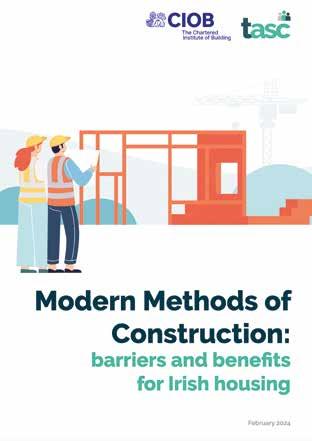
the state because the rest of the constructive sector is notoriously economically cyclical.”
He adds: “The OPW’s Ukrainian Rapid Modular Home programme is a perfect
example of how a mandate could function. Where there was clear demand for units to be delivered using MMC, you had factory owners able to hire people and set up lines in their factories to meet demand exponentially over the course of weeks, getting to the point where they were turning out house buildings in 20 days, having initially taken 60 days. That’s because they were certain that demand was forthcoming. The MMC sector and all of those involved in this project should be commended for how they worked together to deliver this ambitious scheme.”
To advance MMC adoption in Ireland, Joseph Kilroy believes there needs to be increased use of Design & Build contracts and Early Contractor Involvement (ECI).
“While the state’s ability to directly influence private-sector procurement is
KEY RECOMMENDATIONS OF THE CIOB ‘MODERN METHODS OF CONSTRUCTION: BARRIERS AND BENEFITS FOR IRISH HOUSING’ REPORT 2024
REVIEW HEIGHT RESTRICTIONS ON TIMBER WITH INTERNATIONAL EVIDENCE
Ireland’s height restrictions on timber hinder its use in residential buildings. With a need for higher-density urban housing, these limits should be re-examined. While fire safety concerns are valid, other countries with less stringent restrictions use timber safely. A review should consider international examples and updated timber technology.
EXPAND TECHNICAL GUIDANCE DOCUMENTS TO COVER OFFSITE CONSTRUCTION MATERIALS
Testing for building code compliance is slow and costly. Updating regulations to include MMC products could streamline testing, lower costs and boost MMC adoption. Official certification would reassure clients, funders, and insurers about MMC’s reliability.
TAX CONCRETE BASED ON EMBODIED CARBON CONTENT
The current levy on cement doesn’t consider its carbon footprint. A revised approach could tax concrete based on its embodied carbon, encouraging low-carbon alternatives.
ADDITIONAL FISCAL INCENTIVES LIKE VAT REDUCTIONS COULD PROMOTE SUSTAINABLE TIMBER USE
Increase direct social housing builds for rapid delivery
Raising housing targets should include more direct social housing projects. Though costly, direct builds offer control over design and can drive MMC adoption, providing stability for
limited, it can shape its own procurement models, which may then be adopted by the broader industry.
“To promote the adoption of MMC in public building projects, the project delivery timeframe in the design and build framework could be extended. This would allow tenders to propose earlier completion dates than currently possible. If such proposals are evaluated favourably, it would incentivise using offsite construction methods.”
Regarding planning, several challenges arise.
“The lengthy and complex process of securing planning permission in urban areas could be eased through more extensive use of masterplanning. In this approach, public consultation occurs primarily at the masterplan stage, limiting the scope for objections once a plan is finalised, provided the proposed development aligns with that plan. Additionally, active land management - where the state acquires land, installs necessary infrastructure, and then uses, sells, or leases it - would also be beneficial,” Joseph Kilroy concludes.
To learn more about the Chartered Institute of Building, visit www.ciob.org , phone 01 513 8950 or email jkilroy@ciob.org
manufacturers and improving housing delivery.
Greater use of design and build and more ECI are needed to further MMC in Ireland. Government procurement should prioritise MMC, adjusting project timelines to support quicker builds with offsite methods.
The length and difficulty of obtaining planning permission in urban areas can be mitigated to some degree by greater use of master planning. This way, public consultation takes place primarily at the masterplan stage, with limited scope for objections once a plan is in place and once a proposed development is in accordance with that plan. Active land management whereby the state, be it a large local authority or the Land Development Agency (LDA), acquires land, furnishes it with infrastructure, and then either uses it, sells it or leases it, would similarly be helpful. Waiting for the relevant infrastructure to be in place discourages offsite construction. The extent of one-off housing is another barrier to MMC as it impedes standardisation. Upholding the desire of many to live outside cities is a legitimate goal of spatial planning. However, it should not be done at the expense of the environment, congestion, and housing delivery.
In keeping with the principles of sustainable development, ideally, one-off housing would only be permitted in situations where a household has an economic need for proximity to a given piece of land, typically for agricultural work. Otherwise, housing needs should be met within existing villages and towns.
The full CIOB Modern Methods of Construction: barriers and benefits for Irish housing report can be downloaded at www.ciob.org/industry/policy-research/MMC-Ireland
CSRD reporting for corporates will begin from 2025 on a phased basis, JONATHAN
MCKEOWN, Director of ESG, Davy Horizons, sets out the steps contractors should be taking to ensure the data they are collecting and correlating is CSRD compliant.
As the effects of climate change have become more apparent around the world, sustainability is a major talking point in every industry. In construction, the processes and materials used matter to the natural environment in terms of Greenhouse Gas (GHG) emissions, waste, biodiversity, and our health. Many common construction materials have high embedded carbon, use resources and generate waste. On the opportunities side, low carbon technologies, such as heat pumps, solar PV and other renewables, enable energy efficiency and high energy ratings that legislation like nZEB is driving for new developments. Innovations in recycled materials are also enabling the shift to the circular economy in the construction sector.
Following the climate targets set in the 2015 Paris Agreement, the European Union (EU) aims to make Europe the first climate-neutral continent by 2050, striving for a temperature increase of no more than 1.5 degrees Celsius above pre-industrial levels. The EU is leading the charge in global climate policy with a comprehensive framework designed to drive sustainability across all sectors, including real estate.
At the heart of this strategy is the European Green Deal which comprises a series of regulations and directives reshaping how commercial properties are built, operated, and renovated.
One of the key EU policies is the Corporate Sustainability Reporting Directive (CSRD), which is being phased in starting in 2024. It significantly expands the number of companies required to publish sustainability disclosures to over 50,000 (including listed companies, large private companies, and listed SMEs).
The CSRD integrates non-financial environmental, social and governance (ESG) information into management reporting through a sustainability statement with detailed disclosure and data point requirements. This includes mandatory and material ESG and financial information to ensure that company impacts, risks and opportunities are appropriately managed over the short, medium, and long term. CSRD requires assurance of data, initially to a limited assurance level, to improve quality and comparability and prevent greenwashing.
The CSRD ensures financial stakeholders, including investors, consumers, lenders, insurers and other stakeholders, will have

Jonathan McKeown, Director of ESG, Davy Horizons.
access to the necessary information to evaluate financial risks that may result from climate change and other sustainability concerns.
Companies in scope for FY 2025 are EU entities (including EU subsidiaries of nonEU parent companies) for whom two or
more of the following criteria apply:
• Total balance sheet of >€25m
• Net turnover of >€50m
• 250 employees
The CSRD applies to fiscal years starting on or after 01 January 2024, with reporting
starting from 2025 on a phased basis as per the criteria below.
• FY 2025 on 2024 data: Companies previously subject to the Non-Financial Reporting Directive (NFRD) (large, listed companies, large banks and large insurance undertakings - if they have more than 500 employees), as well as large non-EU listed companies with more than 500 employees
• FY 2026 on 2025 data: Other large companies, including other large nonEU listed companies
• FY 2027 on 2026 data: Listed SMEs, including non-EU-listed SMEs. (However, listed SMEs may opt out of the reporting requirements for a further two years).
The CSRD comprises 12 European Sustainability Reporting Standards (ESRS) covering ‘Environment’, ‘Social’, and ‘Governance’.
Reporting entities must publish a set of disclosures in line with CSRD standards, which should be included in the annual integrated report and must align with ESRS standards for all mandatory disclosures and data points and double materiality-relevant impacts.
To prepare for the first CSRD-compliant report, the following steps should be followed:
• Conduct a double materiality assessment, which is mandatory under the CSRD
• Engage with stakeholders to get input and feedback on material non-financial risks
• Undertake a CSRD reporting gap analysis for the material issues identified in the double materiality assessment and recommend actions to fill the identified gaps
• Gather the required data for the mandatory and materiality-based disclosure requirements identified
• Prepare for digital data tagging
• Prepare for third-party assurance of data.
One of the key concepts within CSRD is double materiality.
Double materiality relates to how business activities affect or depend on the environment and people, as well as how the environment and people impact the company’s financial performance across short, medium and long-term timeframes.
The directive requires the company to conduct a double materiality assessment to determine its impacts on the environment and society (impact materiality) and
financial-related environmental and societal risks and opportunities (financial materiality).
Some common environmental impacts for the construction sector include climate change, air and water pollution, biodiversity and circular economy. Common social impacts include modern slavery, wellbeing, health and safety and rights of various stakeholders, such as workers, communities, customers and suppliers.
There are several key steps in undertaking a double materiality assessment. Impacts must be determined by reviewing ESG policies, procedures, data, tools and any previous materiality assessments. Following this, key stakeholders should then be engaged, including those in the value chain and financial stakeholders.
After ranking the impacts based on importance to the business, society, and the environment, it’s important to identify which impacts are material. This assessment should be verified by internal subject matter experts. The business needs to investigate the level of financial impact on its performance, profitability, growth, and reputation for material environmental and social impacts. This can be achieved through workshops, surveys with internal subject matter experts, financial teams, and, if relevant, the company’s sustainability executive committee. Financial impacts that are material for reporting should be determined based on the likelihood and
severity of the financial impact.
Stakeholder engagement is imperative when preparing for CSRD reporting and involves gathering input and feedback to understand the potential impacts of the company on people and the environment. The ESRS defines stakeholders as those who can affect or be affected by the company’s decisions and actions. They can be broken down into key stakeholder groups:
• Affected stakeholders – Individuals or groups whose interests are, or could be, affected by the company’s activities and direct or indirect value chain relationships. This includes employees, customers and suppliers.
• Users of sustainability statements –Primary users of financial reporting, such as investors, lenders, creditors, insurers, asset managers, business partners, regulators, ratings agencies, suppliers, NGOs, trade unions, industry groups and civil society.
The CSRD gap analysis evaluates the business’s readiness to meet the requirements for mandatory disclosure and the material impacts reporting from the double materiality assessment. A gap analysis should include the following five elements.
1. Existing data across all mandatory data points defined in ESRS and additional ones identified by the double


materiality assessment covering ESGrelated governance, strategy, policies, processes, targets, actions, and metrics.
2. Assurance of data and disclosure: CSRD assurance and competency requirements require ISO 14064-3 and ISO 14065 for GHG Accounting.
3. Alignment with the CSRD requirement for Climate Transition Plans and Task Force on Climate-related Financial Disclosures (TCFD) to strengthen risk assessment and reporting on climaterelated physical and transition risks.
4. Alignment with the CSRD requirement for EU Taxonomy alignment in future and growth of tracking and disclosure on sustainable market activities, including turnover, capital expenditure (CAPEX), operating expenditure (OPEX), mergers & acquisitions (M&A) and investments.
5. Preparedness for digital data submission.
Properly collecting data is essential for CSRD compliance. Environmental, social, and governance (ESG) data needs to be as reliable as financial data, meaning it should be verifiable and auditable by a third party. Collecting data for CSRD compliance presents challenges, including diverse data types, inconsistent formats, scattered sources, disaggregated data and the need for verifiability. This can be especially problematic for the construction sector where the data can be sparse or even not captured at all.
Some examples of the data required include:
• Governance – Processes, controls, and procedures used to monitor and manage risks, impacts, and opportunities
• Strategy – How the company’s strategy and business model interact with its material impacts, risks, and opportunities and plans to address them
• Impact, risk, and opportunity management – Processes to identify, assess and manage these through policies, plans, procedures and actions
• Metrics and targets – How performance and process are measured against targets set, KPIs, etc
• Data collection – The current approach to sustainability-related data collection to inform business decision-making, sustainability reporting, and ESG investors.
There are challenges in the data collection process, including its availability. It is imperative to start gathering earlycorporates in the second wave must report in 2026 on 2025 data. For these corporates, data gathering systems should be in place by 01 January 2025. Regular data collection is essential - once a year is probably not enough. Investing in reputable software is key to managing data, reports, goals, and actions in one place.
Digital data tagging involves labelling data within digital documents using specific codes to make the information machinereadable and easily accessible. This is done through the Extensible Business Reporting Language (XBRL), a standardised language for exchanging business information. By applying XBRL tagging to sustainability reports, organisations enhance data quality, ensure transparency and facilitate the comparability of information across industries. This digitisation supports detailed data collection and helps prevent greenwashing by ensuring that reports are verifiable and reliable.
Assurance and verification are mandatory requirements for CSRD disclosures to ensure that data quality is credible and reliable and to avoid greenwashing. Initially, this will be at a ‘limited’ assurance level
and audited by independent and competent assurance service providers. This will then transition to the more demanding level of ‘reasonable’ assurance, which is currently required for financial reports. ‘Reasonable’ assurance will require the use of sustainability assurance standards and practitioners who meet these competency requirements.
Preparing for CSRD reporting is a major undertaking even for large plcs that have financial and headcount resources available. Those corporates in the second wave are most exposed and lack the resources, knowledge base and bandwidth to carry out such a resource-intensive project.
The CSRD represents a fundamental shift towards transparency and accountability across industries, especially within construction. As the construction industry navigates these regulatory landscapes, CSRD compliance emerges as a legal requirement and a strategic opportunity. Even corporates not captured by the CSRD will see an increase in non-financial data requests from their value chain and procurement processes. Those corporates able to provide the required data, policies and procedures will find themselves at an advantage.
Davy Horizons is a team of sustainability consultants with world-class expertise across the environmental, social and governance (ESG) verticals. The team has supported the sustainability programmes of leading Irish, UK and international businesses, both public and private, across many sectors.
To learn more about CSRD Reporting requirements, visit www.davy.ie/capitalmarkets/esg-advisory or scan the QR code

IRENE RONDINI, Communications Lead and Biodiversity Support Officer, Irish Green Building Council, looks at some of the latest developments in green finance and provides details on upcoming IGBC events, including the Better Homes Conference 2024 in November and an important webinar on the Home Performance Index.
The current surge in house prices and the need to deliver more homes will be one of the main topics of the upcoming general election. However, with summer 2024 being the hottest on record globally, one cannot forget the other major crisis we face: Climate. In this article, we explore the role of innovation and green finance in providing the homes we need while ensuring we remain within the planet’s ecological boundaries.
When we think of sustainable homes, energy efficiency is often the focus, but many other factors are just as critical. Green homes should prioritise good indoor air quality through proper ventilation, use of low pollutant and low embodied-carbon materials and be built in accessible, walkable locations. To be truly sustainable, a home must also be adaptable to significant changes over time to remain in use for as long as possible, conserve water and enhance biodiversity. This goes far beyond achieving a good BER certification.
The Home Performance Index (HPI), developed by the Irish Green Building Council (IGBC), supports the consideration of all these aspects in new homes built in Ireland. HPI is the national certification system that sets the standard for energy efficiency, environmental responsibility, and overall performance in residential developments. Similar to widely recognised certifications such as LEED and BREEAM for commercial buildings, HPI is tailored specifically for the Irish housing sector and aligns with Irish building regulations and the international WELL certification.
There are simple steps that the industry can take to reduce embodied carbon and deliver sustainable homes. First, renovating existing buildings can save substantial carbon emissions associated with new properties and infrastructure. The embodied carbon emissions associated with a deep residential renovation are a quarter of a new build. When we do build new, the types of homes being built can have a significant impact on carbon emissions. For instance, connected dwellings, such as terraced homes, can significantly reduce the embodied carbon of a development (A side gable wall in semi-detached houses generates four to five times more embodied carbon per square metre than a party wall between terrace dwellings).
Furthermore, greenfield housing developments outside towns and cities can contribute up to 30% more embodied carbon per home than equivalent infill developments that use existing infrastructure (Viable Homes, 2024). External area and infrastructure associated with lower-density developments, such as semi-detached houses, produce 32% additional carbon emissions, while those associated with higher-density development, such as apartment buildings, only generate an increase of 13% (As part of the RE-CUGI project, 2024).


PLACE EARLY-STAGE CARBON EVALUATION TOOL
To support planners and developers in delivering sustainable homes and building on these insights, the IGBC is developing a tool that allows for early-stage carbon evaluations of different residential designs and their relationship with the surrounding area. The tool, called PLACE, will account for embodied carbon in both the construction of buildings and the infrastructure serving them, as well as operational carbon and the transport emissions of future occupants.
Beyond carbon evaluations, the tool aims to standardise a method for assessing the liveability of residential areas, with benchmarks being developed in consultation with key stakeholders. To be genuinely sustainable, a building also needs to be properly operated and maintained, and good communication with homeowners and tenants is key. To improve the handover process for homeowners, the IGBC is working on the development of a

user-friendly guide. Written in plain English and free of technical jargon, the guide focuses on maintaining and operating essential home systems like ventilation and heating while also offering practical tips for saving energy and water, as well as enhancing biodiversity. The guidance document is being developed in collaboration with Cairn Homes with support from Construct Innovate.
Sustainable financing mechanisms are also required for greener homes to become the new norm. This means financial institutions and developers have the tools and frameworks needed to support green home initiatives.
Key to supporting this transition is the EU Taxonomy, a classification system which provides developers, investors, and policymakers with appropriate definitions for which economic activities can be considered environmentally sustainable. The aim is to create security for investors, protect private investors from greenwashing, help companies become more climate-friendly,
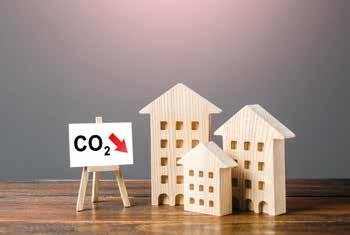
mitigate market fragmentation and help shift investments where they are most needed. It will play an important role in helping the EU and Ireland scale up sustainable investment, including in the construction sector.
Collaborating with other European Green Building Councils, the IGBC is working on the national interpretation of the EU Taxonomy while helping banks, residential investors, and solution providers align with it, paving the way for green homes and the development of green loan and mortgage programmes. A new version of the Home Performance Index (v 3.1), aligned with the EU Taxonomy, will be launched by the end of the year. A webinar on this topic will be hosted on 07 November by the IGBC in collaboration with the German Sustainable Building Council (DGNB).
In Ireland, AIB and HBFI already offer discounted loans to residential developers who adhere to the HPI certification. By providing this financial support to developers, they ensure that the transition to sustainable housing is not only environmentally responsible but also economically viable, encouraging more stakeholders to invest in eco-friendly, energy-efficient developments.
These topics will be explored in depth at the upcoming Better Homes Conference on 15 November. The event - focusing on affordable, sustainable homes - will feature morning panels on innovation and green finance, followed by an afternoon roundtable with international experts.
For more details on the Better Homes Conference 2024, visit www.igbc.ie/events or scan the QR code

IRENE RONDINI, Communications Lead and Biodiversity Support, Irish Green Building Council, reviews some of the many highlights from World Green Building Week 2024.
During World Green Building Week 2024 (09 - 13 September), the Irish Green Building Council (IGBC) hosted several events and tours for our members.
The week kicked off with a site visit to 25 North Wall Quay, a 1990s building transformed into a net zero-carbon office. IGBC members had the opportunity to explore this impressive project with insights from Paul Cleary and Ellen McKinney of IPUT Real Estate and Neal Patterson of Henry J Lyons Architects. They discussed key strategies, such as retaining 75% of the existing reinforced concrete structure, using lighter materials for additional storeys, maximising modular assembly, and implementing all-electric M&E systems. The building is currently creating approximately only 300kg CO2e/m² and 55kWh/m² – fully in line with their netzero journey.
On Tuesday, we travelled south to explore the Cobh Urban Design Plan. Giulia Vallone, former Senior Architect and Urban Designer, showcased Cork County Council’s efforts to integrate nature into urban spaces, including the national pilot scheme of the rain garden demonstrator. Alan Costello, Senior Scientist at Cork County Council, presented findings from a year of water quality monitoring, demonstrating the rain garden’s effectiveness in removing contaminants. We also heard from Hendrick Verwey and Ruth Ring of award-winning Cobh Tidy Towns, who emphasised the importance of citizen engagement in promoting biodiversity in the built environment.
On Wednesday, the IGBC ESG Community of Practice gathering featured a panel discussing the ‘nuts and bolts’ of the Corporate Sustainability Reporting Directive (CSRD). Panellists Che McGann (Goodbody Clearstream), Krystyna Rawicz (KRA Renewables), Rachael McGinley (CBRE), and Lorraine FitzGerald (Glenveagh Properties) were moderated by Paul Kelly (AIB). Key advice included: Start now and collaborate; Identify gaps and collect data; Form a cross-disciplinary team; and View the workload as an opportunity to improve practices.
On Thursday morning, the IGBC convened a special cross-disciplinary discussion at Engineers Ireland headquarters on improving collaboration between the different disciplines to reduce

carbon emissions in the built environment. This was attended by architects, engineers, surveyors, planners, developers and contractors and was held in conjunction with the various professional institutes such as ACEI, CIF, Engineers Ireland, IPI, RIAI and SCSI. Lack of early collaboration can result in key opportunities to cut carbon emissions being missed on projects. This discussion aimed to kick-start a process of getting all the different disciplines in the built environment working together to reduce our carbon footprint.
On Thursday evening, IGBC Platinum, Gold, and Silver members gathered at Indeed headquarters in the Dublin Docklands for an exclusive event. Attendees networked, enjoyed food and drinks, and learned about Indeed’s sustainability strategy and LEED-Gold headquarters.
A panel discussion with industry leaders Chris Croly (BDP), Banbha McCann (Henry J Lyons), Susan McGarry (Ecocem), and Stephen O’Shea (Cairn Homes) offered thought-provoking ideas on how to decarbonise Ireland’s built environment with the audience chipping in via an interactive Mentimeter discussion.
Finally, on Friday, IGBC members toured the Treasury Building renovation project, which has saved 1,905 tonnes of CO2 emissions—equivalent to driving from
Dublin to Hong Kong 515 times. Originally built in 1946 as Boland’s Bakery and converted to office space in the 1980s, the building is now being extended and renovated by Google. John Casey from CORA Consulting, who is working on this project, noted that 85 tonnes of structural steel was reused, and materials like cladding were uploaded to the IGBC’s Construction Materials Exchange pilot platform for reuse in other projects. The project is currently achieving an impressive 207 kg CO2e/m², significantly below the target of 500 kg CO2e/m².
On Tuesday, 17 September, the IGBC teamed up with Cundall and IGBC’s Circularity Lead Giovanni Impoco and joined other speakers to discuss advancing circular construction and decarbonisation in Ireland’s built environment. Key takeaways of this industry events: Understand building typology and energy use; Collect and track data to set decarbonisation targets; Engage technical advisors early, and Design for both construction and deconstruction to maximise material use.
The IGBC is deeply grateful to all members who organised events and tours to support World Green Building Week and advance awareness of sustainability practices.
Cimsa, a Turkish-listed global building materials company – and a subsidiary of publicly listed global conglomerate Sabanci Holdings, has reached an agreement to acquire 94.7% of Mannok for an overall enterprise value of €330m. The local Mannok leadership team will retain a 5.3% interest.
Under the agreement, which is subject to customary approvals, the Mannok brand will be retained as a growth hub for Cimsa and Sabanci in Ireland and the UK, and the business will continue to be led by local management. This agreement marks Cimsa’s third major investment in the past three years, following recent investments in Spain and the US, and underpins its ambition to become a scale player in the UK and Irish markets.
Employing approximately 800 staff, Mannok comprises two divisions, Building Products and Packaging, focussing on the island of Ireland and GB markets.
Sabanci, a global conglomerate, employs over 60,000 people in 14 countries across five continents. Sabanci is engaged in a wide range of business activities, including cement and building materials, energy and climate technologies, industrials, banking and financial services, retail and digital sectors.
Commenting, Umut Zenar, CEO, Cimsa, said: “We believe this agreement marks the beginning of a new era for Mannok. At Cimsa, our model is to back great local businesses and management, and we look forward to creating new employment opportunities in the
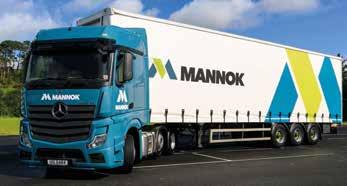
region as we support Mannok’s continuing growth and sustainability ambitions. Given its border location, Mannok has unique access to UK and EU markets, and we see it as a key stepping stone in expanding our footprint in western Europe. For Mannok staff, joining the Sabanci ecosystem will also present a world of career development opportunities.
Adrian Barden, Chairman, Mannok, commented: “Cimsa and the broader Sabanci group are a superb fit for Mannok as new longterm, strategic owners with excellent sustainability credentials and know-how. The group is steeped in cement manufacture and building products and, as a diverse conglomerate, it also has interests in retail and food, important sectors for our packaging business.”
With the huge increase in photovoltaics being installed on both newbuild and existing buildings, Kingspan Insulated Panels has developed a unique fixing system to ensure that this can be done both safely and securely. The Kingspan PowerPlus KS1000RW System has been rigorously tested to FM4478. This system comprises the QuadCore KS1000RW Roof Panel, the PoweRail RW, and a Longi PV module.
This marks the first step in Kingspan’s journey to offer a full range of solar solutions tested to the relevant FM Approvals standards. The FM Approvals certification mark verifies that a product meets its stated conditions of performance, safety, and quality. FM4478 states the approval requirements for rigid PV modules that are installed with a roof assembly. To achieve certification, the assembly is tested in a number of ways, including being subjected to fire from above the structural deck, simulated wind uplift, hail damage, along with electrical performance and safety.
Kingspan PoweRail RW fixes directly to the external profile of the roof panel. A major benefit of using this fixing system is that the Kingspan Panel Warranty is not compromised*. Expert technical design support is available to ensure the best configuration for your building.
Kingspan’s RW profile insulated panel systems are used on roofs all over Ireland, and PoweRail RW can be used to retrofit existing roofs with PV, as well as helping to meet the current requirements for PV on new buildings, making solar PV module installation faster, simpler and more robust. This simple but effective fixing method helps to maintain the integrity of the roof and, with a manufacturer warranty of up to 25 years, carries an assurance of performance to provide peace of mind for specifiers installers and building owners alike.
Additionally, the PoweRail RW has MCS certification: MCS 012Pitched Roof Installation Kits, which includes quality management,


and third-party resistance to wind uplift and weathertightness testing.
*Warranty subject to Terms and Conditions, Contact Kingspan technical team for more information. For further information, contact 042 9698 500, visit www.kingspanpanels.ie

This November, Movember is calling on Ireland’s construction industry to lay the foundation for something bigger. For 30 epic days, Movember challenges you to grab your mates, grow some magnificent mo’s, raise vital funds and compete for The Crown in the ‘Movember Construction Challenge’. It’s not just about competition - it’s about standing up for the one in eight Irish men diagnosed with prostate cancer and addressing the staggering reality that 75% of lives lost to suicide are men.
Whether you’re on site, in the office or out on the road, everyone in construction - from builders and tradesmen to suppliers and engineers - can join the Movember Construction Challenge and make a difference.
1. Sign Up: Head to Movember.com and create your personal ‘Mo Space’
2. Create Your Team: Set up your company’s Movember Team Mo Space and rally the crew.
3. Join the Challenge: Once your team page is live, join the Construction Challenge.
4. Spread the Word: Get the whole industry involved - challenge your competitors and partners to join the cause.
5. Need assistance: Movember has got your back. Drop a line to Kevin at kevin.dempsey@movember.com - he’ll get you sorted.
By joining the Movember Construction Challenge, you’re backing groundbreaking research and programmes, including the ‘Movember Ahead of The Game’ initiative, which has already trained over 4,500 young players, parents, and coaches across Ireland to build mentally resilient communities.

So, are you up for the challenge? Let’s build something amazing together this Hairy Season.
For full details, email kevin.dempsey@movember.com, visit www.movember.com, or scan the QR code














Segregated Skip Management
LEED Reporting with Precise Data
Sustainable Waste Solutions
Waste Budget Tracker
Hazardous Waste Management
Cable Skips - New Revenue Stream
High Rebates on commodities
Dedicated Account Manager And many more...


With over 40 years in the waste management sector, Greyhound Recycling has seen a lot of changes, but one thing that has stayed the same is our mission to provide the best waste management service, prioritising recycling and sustainability In 2023, we led Ireland with the highest recycling rates, achieving a 98% recycle and recovery rate, according to the EPA
Our new system can cut down on 94 55% of CO2 emissions directly Yes, EASi is a revolutionary system that is designed to

be the most environmentally friendly waste management solution on the market The EASi system effortlessly turns the negatives commonly associated with waste management (high costs, lack of space, storage and collection issues, bad smells) into positives With EASi, you can take control of your waste by introducing the most sustainable, low-maintenance, and clean system available We’ve solved it all, and the solution is EASi

